Innovation Commercialization in High-Tech Firms
VerifiedAdded on 2020/06/06
|18
|5792
|228
AI Summary
The assignment delves into the crucial aspects of innovation and commercialization within high-technology firms. It examines various leadership styles that foster innovation, the challenges of concurrent commercialization and new product adoption, and the role of regional innovation networks in driving commercial success. The analysis considers the unique characteristics of multi-invention contexts and explores how technological advancements, intellectual property complexity, and network structures influence the commercialization process.
Contribute Materials
Your contribution can guide someone’s learning journey. Share your
documents today.
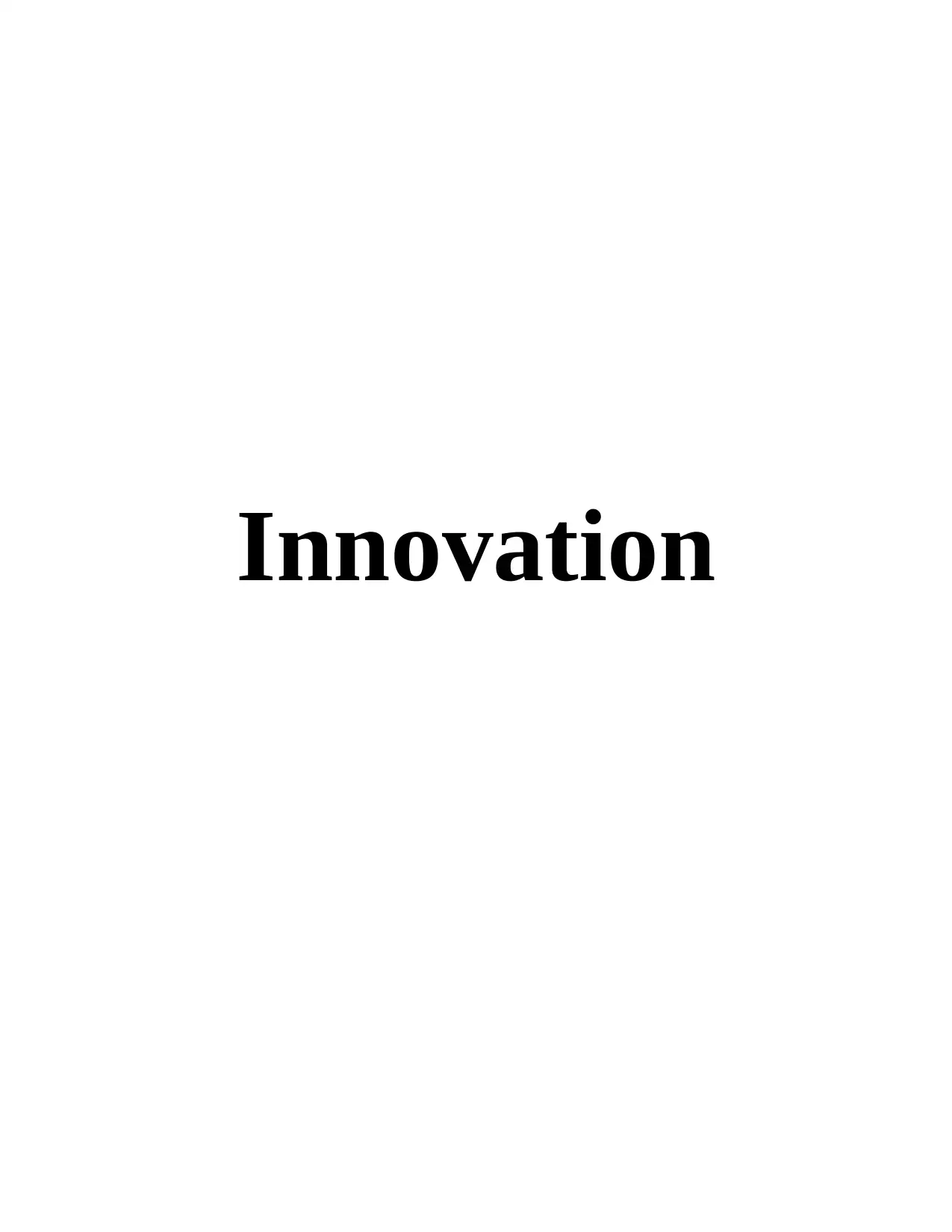
Innovation
Secure Best Marks with AI Grader
Need help grading? Try our AI Grader for instant feedback on your assignments.
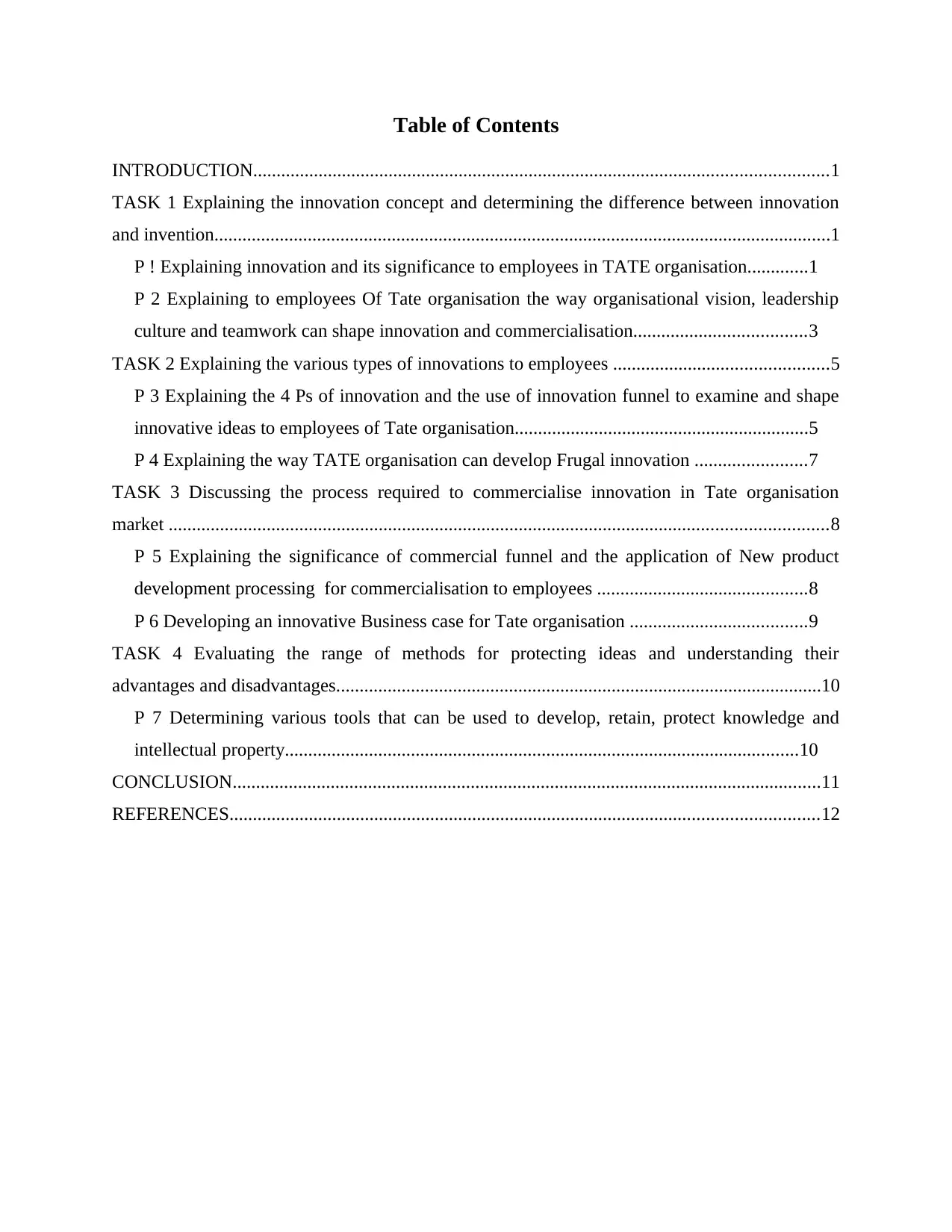
Table of Contents
INTRODUCTION...........................................................................................................................1
TASK 1 Explaining the innovation concept and determining the difference between innovation
and invention....................................................................................................................................1
P ! Explaining innovation and its significance to employees in TATE organisation.............1
P 2 Explaining to employees Of Tate organisation the way organisational vision, leadership
culture and teamwork can shape innovation and commercialisation.....................................3
TASK 2 Explaining the various types of innovations to employees ..............................................5
P 3 Explaining the 4 Ps of innovation and the use of innovation funnel to examine and shape
innovative ideas to employees of Tate organisation...............................................................5
P 4 Explaining the way TATE organisation can develop Frugal innovation ........................7
TASK 3 Discussing the process required to commercialise innovation in Tate organisation
market .............................................................................................................................................8
P 5 Explaining the significance of commercial funnel and the application of New product
development processing for commercialisation to employees .............................................8
P 6 Developing an innovative Business case for Tate organisation ......................................9
TASK 4 Evaluating the range of methods for protecting ideas and understanding their
advantages and disadvantages........................................................................................................10
P 7 Determining various tools that can be used to develop, retain, protect knowledge and
intellectual property..............................................................................................................10
CONCLUSION..............................................................................................................................11
REFERENCES..............................................................................................................................12
INTRODUCTION...........................................................................................................................1
TASK 1 Explaining the innovation concept and determining the difference between innovation
and invention....................................................................................................................................1
P ! Explaining innovation and its significance to employees in TATE organisation.............1
P 2 Explaining to employees Of Tate organisation the way organisational vision, leadership
culture and teamwork can shape innovation and commercialisation.....................................3
TASK 2 Explaining the various types of innovations to employees ..............................................5
P 3 Explaining the 4 Ps of innovation and the use of innovation funnel to examine and shape
innovative ideas to employees of Tate organisation...............................................................5
P 4 Explaining the way TATE organisation can develop Frugal innovation ........................7
TASK 3 Discussing the process required to commercialise innovation in Tate organisation
market .............................................................................................................................................8
P 5 Explaining the significance of commercial funnel and the application of New product
development processing for commercialisation to employees .............................................8
P 6 Developing an innovative Business case for Tate organisation ......................................9
TASK 4 Evaluating the range of methods for protecting ideas and understanding their
advantages and disadvantages........................................................................................................10
P 7 Determining various tools that can be used to develop, retain, protect knowledge and
intellectual property..............................................................................................................10
CONCLUSION..............................................................................................................................11
REFERENCES..............................................................................................................................12
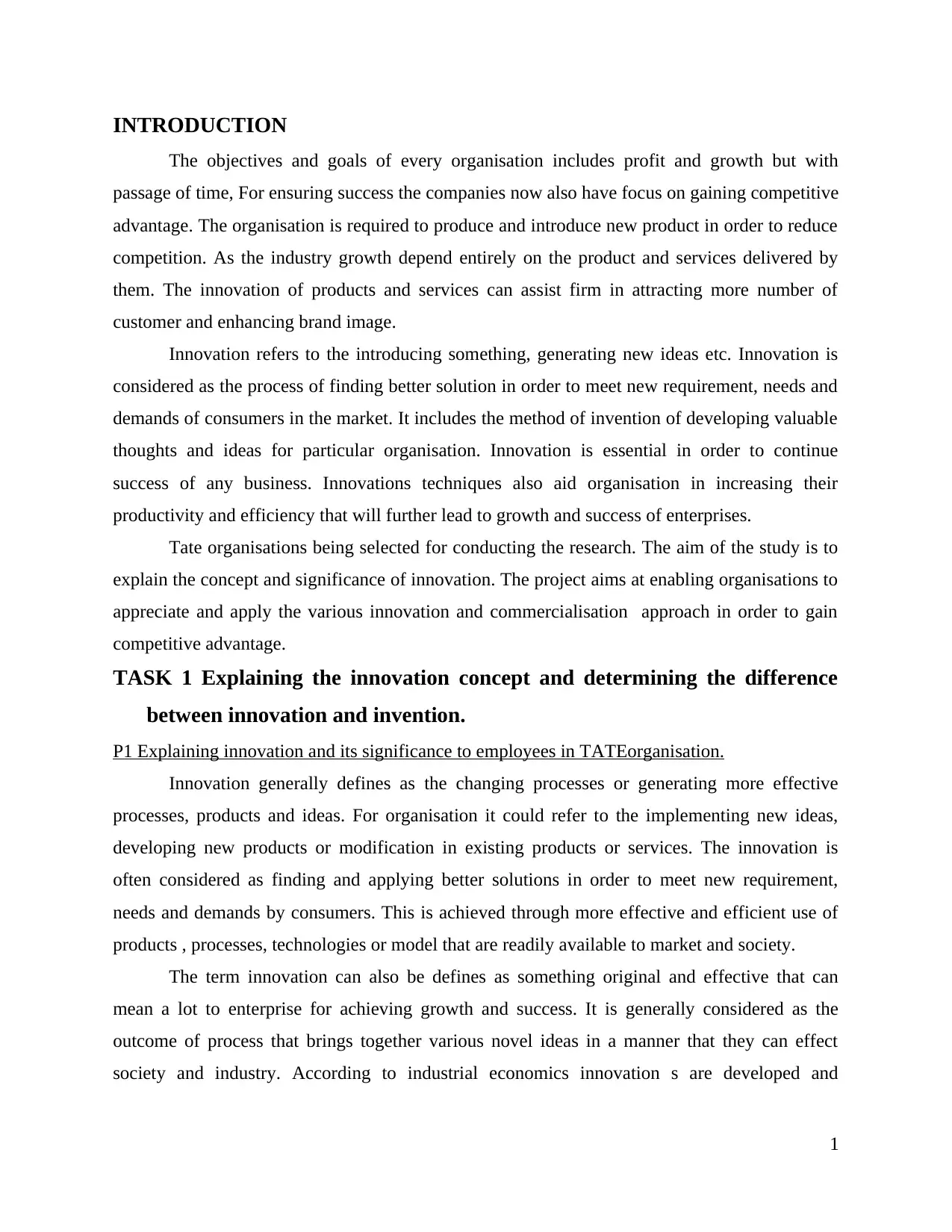
INTRODUCTION
The objectives and goals of every organisation includes profit and growth but with
passage of time, For ensuring success the companies now also have focus on gaining competitive
advantage. The organisation is required to produce and introduce new product in order to reduce
competition. As the industry growth depend entirely on the product and services delivered by
them. The innovation of products and services can assist firm in attracting more number of
customer and enhancing brand image.
Innovation refers to the introducing something, generating new ideas etc. Innovation is
considered as the process of finding better solution in order to meet new requirement, needs and
demands of consumers in the market. It includes the method of invention of developing valuable
thoughts and ideas for particular organisation. Innovation is essential in order to continue
success of any business. Innovations techniques also aid organisation in increasing their
productivity and efficiency that will further lead to growth and success of enterprises.
Tate organisations being selected for conducting the research. The aim of the study is to
explain the concept and significance of innovation. The project aims at enabling organisations to
appreciate and apply the various innovation and commercialisation approach in order to gain
competitive advantage.
TASK 1 Explaining the innovation concept and determining the difference
between innovation and invention.
P1 Explaining innovation and its significance to employees in TATEorganisation.
Innovation generally defines as the changing processes or generating more effective
processes, products and ideas. For organisation it could refer to the implementing new ideas,
developing new products or modification in existing products or services. The innovation is
often considered as finding and applying better solutions in order to meet new requirement,
needs and demands by consumers. This is achieved through more effective and efficient use of
products , processes, technologies or model that are readily available to market and society.
The term innovation can also be defines as something original and effective that can
mean a lot to enterprise for achieving growth and success. It is generally considered as the
outcome of process that brings together various novel ideas in a manner that they can effect
society and industry. According to industrial economics innovation s are developed and
1
The objectives and goals of every organisation includes profit and growth but with
passage of time, For ensuring success the companies now also have focus on gaining competitive
advantage. The organisation is required to produce and introduce new product in order to reduce
competition. As the industry growth depend entirely on the product and services delivered by
them. The innovation of products and services can assist firm in attracting more number of
customer and enhancing brand image.
Innovation refers to the introducing something, generating new ideas etc. Innovation is
considered as the process of finding better solution in order to meet new requirement, needs and
demands of consumers in the market. It includes the method of invention of developing valuable
thoughts and ideas for particular organisation. Innovation is essential in order to continue
success of any business. Innovations techniques also aid organisation in increasing their
productivity and efficiency that will further lead to growth and success of enterprises.
Tate organisations being selected for conducting the research. The aim of the study is to
explain the concept and significance of innovation. The project aims at enabling organisations to
appreciate and apply the various innovation and commercialisation approach in order to gain
competitive advantage.
TASK 1 Explaining the innovation concept and determining the difference
between innovation and invention.
P1 Explaining innovation and its significance to employees in TATEorganisation.
Innovation generally defines as the changing processes or generating more effective
processes, products and ideas. For organisation it could refer to the implementing new ideas,
developing new products or modification in existing products or services. The innovation is
often considered as finding and applying better solutions in order to meet new requirement,
needs and demands by consumers. This is achieved through more effective and efficient use of
products , processes, technologies or model that are readily available to market and society.
The term innovation can also be defines as something original and effective that can
mean a lot to enterprise for achieving growth and success. It is generally considered as the
outcome of process that brings together various novel ideas in a manner that they can effect
society and industry. According to industrial economics innovation s are developed and
1
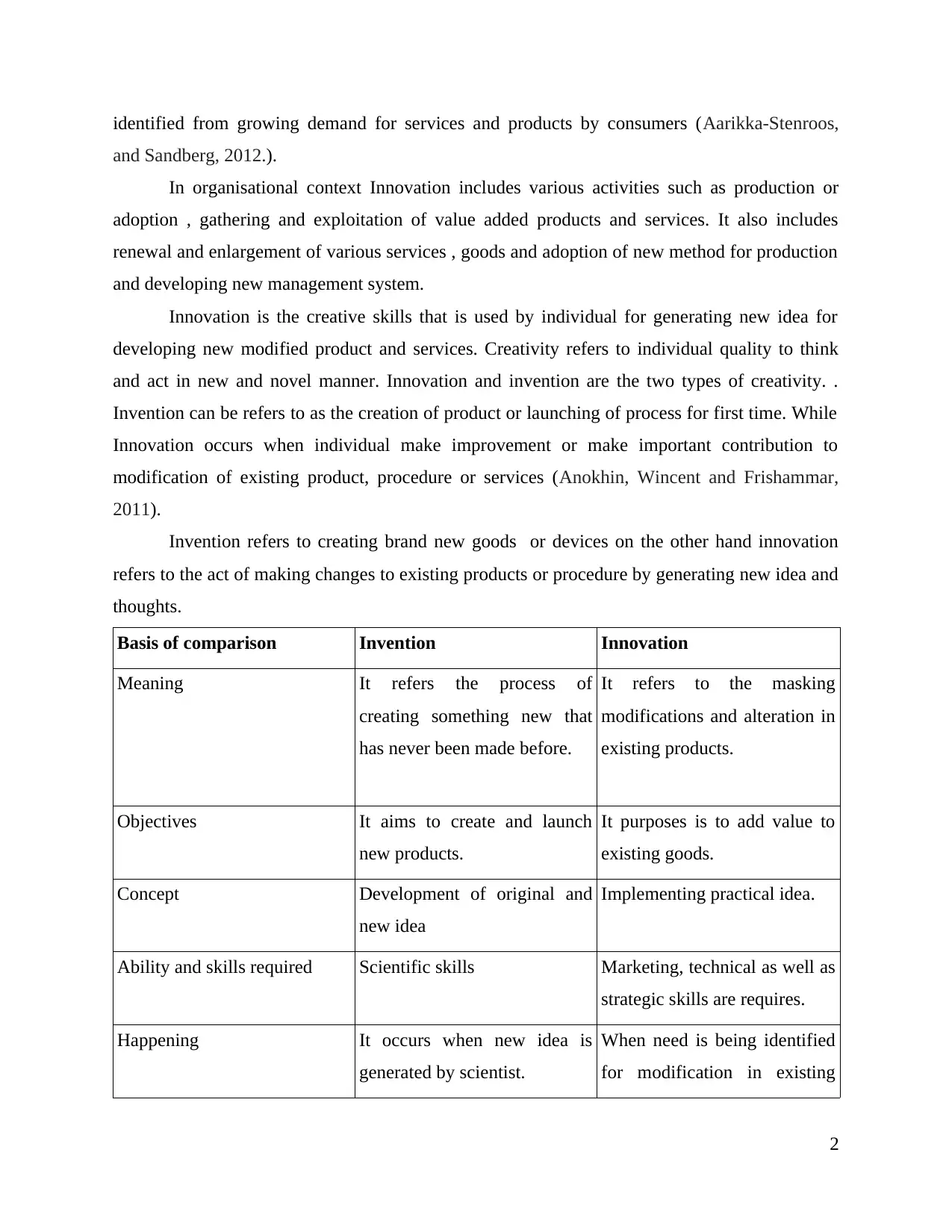
identified from growing demand for services and products by consumers (Aarikka-Stenroos,
and Sandberg, 2012.).
In organisational context Innovation includes various activities such as production or
adoption , gathering and exploitation of value added products and services. It also includes
renewal and enlargement of various services , goods and adoption of new method for production
and developing new management system.
Innovation is the creative skills that is used by individual for generating new idea for
developing new modified product and services. Creativity refers to individual quality to think
and act in new and novel manner. Innovation and invention are the two types of creativity. .
Invention can be refers to as the creation of product or launching of process for first time. While
Innovation occurs when individual make improvement or make important contribution to
modification of existing product, procedure or services (Anokhin, Wincent and Frishammar,
2011).
Invention refers to creating brand new goods or devices on the other hand innovation
refers to the act of making changes to existing products or procedure by generating new idea and
thoughts.
Basis of comparison Invention Innovation
Meaning It refers the process of
creating something new that
has never been made before.
It refers to the masking
modifications and alteration in
existing products.
Objectives It aims to create and launch
new products.
It purposes is to add value to
existing goods.
Concept Development of original and
new idea
Implementing practical idea.
Ability and skills required Scientific skills Marketing, technical as well as
strategic skills are requires.
Happening It occurs when new idea is
generated by scientist.
When need is being identified
for modification in existing
2
and Sandberg, 2012.).
In organisational context Innovation includes various activities such as production or
adoption , gathering and exploitation of value added products and services. It also includes
renewal and enlargement of various services , goods and adoption of new method for production
and developing new management system.
Innovation is the creative skills that is used by individual for generating new idea for
developing new modified product and services. Creativity refers to individual quality to think
and act in new and novel manner. Innovation and invention are the two types of creativity. .
Invention can be refers to as the creation of product or launching of process for first time. While
Innovation occurs when individual make improvement or make important contribution to
modification of existing product, procedure or services (Anokhin, Wincent and Frishammar,
2011).
Invention refers to creating brand new goods or devices on the other hand innovation
refers to the act of making changes to existing products or procedure by generating new idea and
thoughts.
Basis of comparison Invention Innovation
Meaning It refers the process of
creating something new that
has never been made before.
It refers to the masking
modifications and alteration in
existing products.
Objectives It aims to create and launch
new products.
It purposes is to add value to
existing goods.
Concept Development of original and
new idea
Implementing practical idea.
Ability and skills required Scientific skills Marketing, technical as well as
strategic skills are requires.
Happening It occurs when new idea is
generated by scientist.
When need is being identified
for modification in existing
2
Secure Best Marks with AI Grader
Need help grading? Try our AI Grader for instant feedback on your assignments.
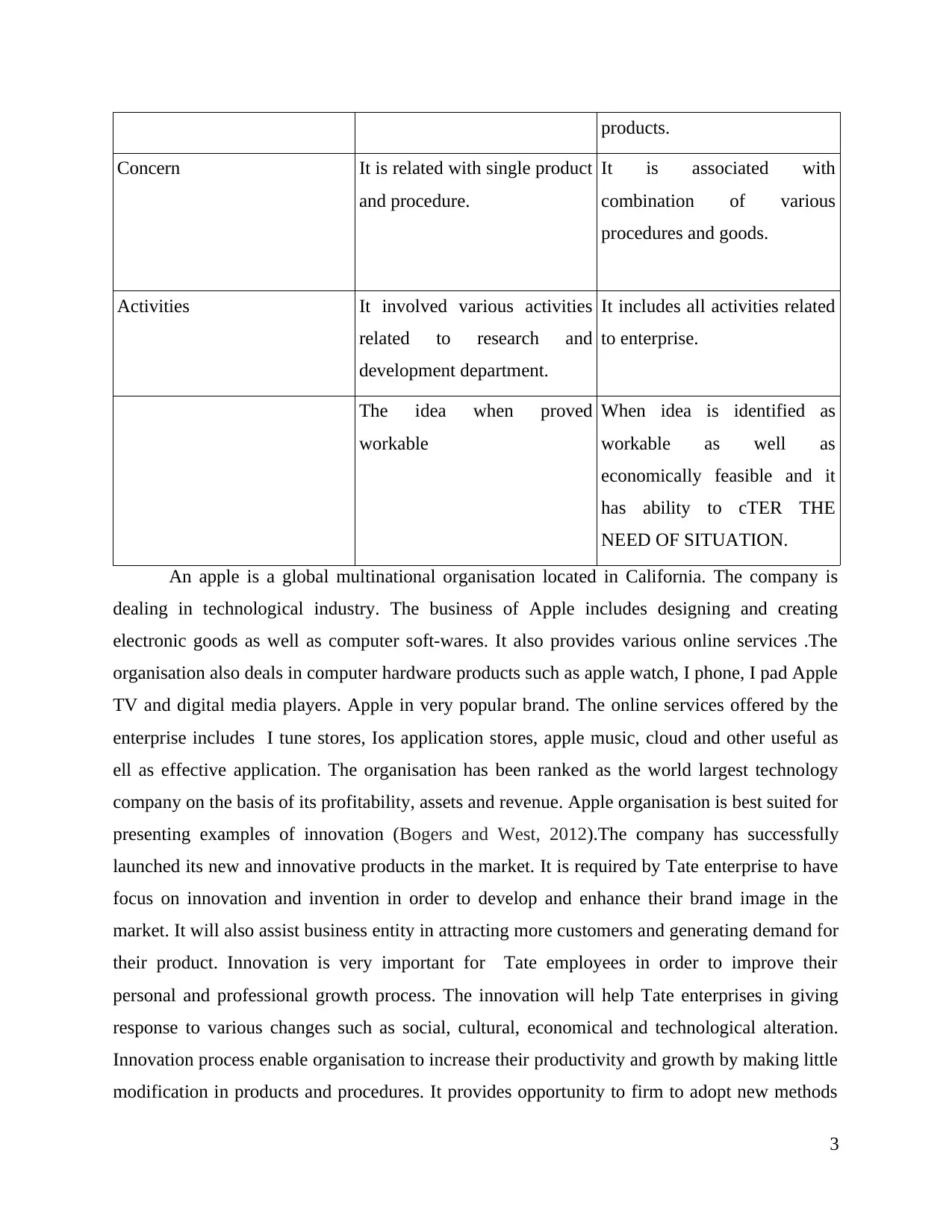
products.
Concern It is related with single product
and procedure.
It is associated with
combination of various
procedures and goods.
Activities It involved various activities
related to research and
development department.
It includes all activities related
to enterprise.
The idea when proved
workable
When idea is identified as
workable as well as
economically feasible and it
has ability to cTER THE
NEED OF SITUATION.
An apple is a global multinational organisation located in California. The company is
dealing in technological industry. The business of Apple includes designing and creating
electronic goods as well as computer soft-wares. It also provides various online services .The
organisation also deals in computer hardware products such as apple watch, I phone, I pad Apple
TV and digital media players. Apple in very popular brand. The online services offered by the
enterprise includes I tune stores, Ios application stores, apple music, cloud and other useful as
ell as effective application. The organisation has been ranked as the world largest technology
company on the basis of its profitability, assets and revenue. Apple organisation is best suited for
presenting examples of innovation (Bogers and West, 2012).The company has successfully
launched its new and innovative products in the market. It is required by Tate enterprise to have
focus on innovation and invention in order to develop and enhance their brand image in the
market. It will also assist business entity in attracting more customers and generating demand for
their product. Innovation is very important for Tate employees in order to improve their
personal and professional growth process. The innovation will help Tate enterprises in giving
response to various changes such as social, cultural, economical and technological alteration.
Innovation process enable organisation to increase their productivity and growth by making little
modification in products and procedures. It provides opportunity to firm to adopt new methods
3
Concern It is related with single product
and procedure.
It is associated with
combination of various
procedures and goods.
Activities It involved various activities
related to research and
development department.
It includes all activities related
to enterprise.
The idea when proved
workable
When idea is identified as
workable as well as
economically feasible and it
has ability to cTER THE
NEED OF SITUATION.
An apple is a global multinational organisation located in California. The company is
dealing in technological industry. The business of Apple includes designing and creating
electronic goods as well as computer soft-wares. It also provides various online services .The
organisation also deals in computer hardware products such as apple watch, I phone, I pad Apple
TV and digital media players. Apple in very popular brand. The online services offered by the
enterprise includes I tune stores, Ios application stores, apple music, cloud and other useful as
ell as effective application. The organisation has been ranked as the world largest technology
company on the basis of its profitability, assets and revenue. Apple organisation is best suited for
presenting examples of innovation (Bogers and West, 2012).The company has successfully
launched its new and innovative products in the market. It is required by Tate enterprise to have
focus on innovation and invention in order to develop and enhance their brand image in the
market. It will also assist business entity in attracting more customers and generating demand for
their product. Innovation is very important for Tate employees in order to improve their
personal and professional growth process. The innovation will help Tate enterprises in giving
response to various changes such as social, cultural, economical and technological alteration.
Innovation process enable organisation to increase their productivity and growth by making little
modification in products and procedures. It provides opportunity to firm to adopt new methods
3
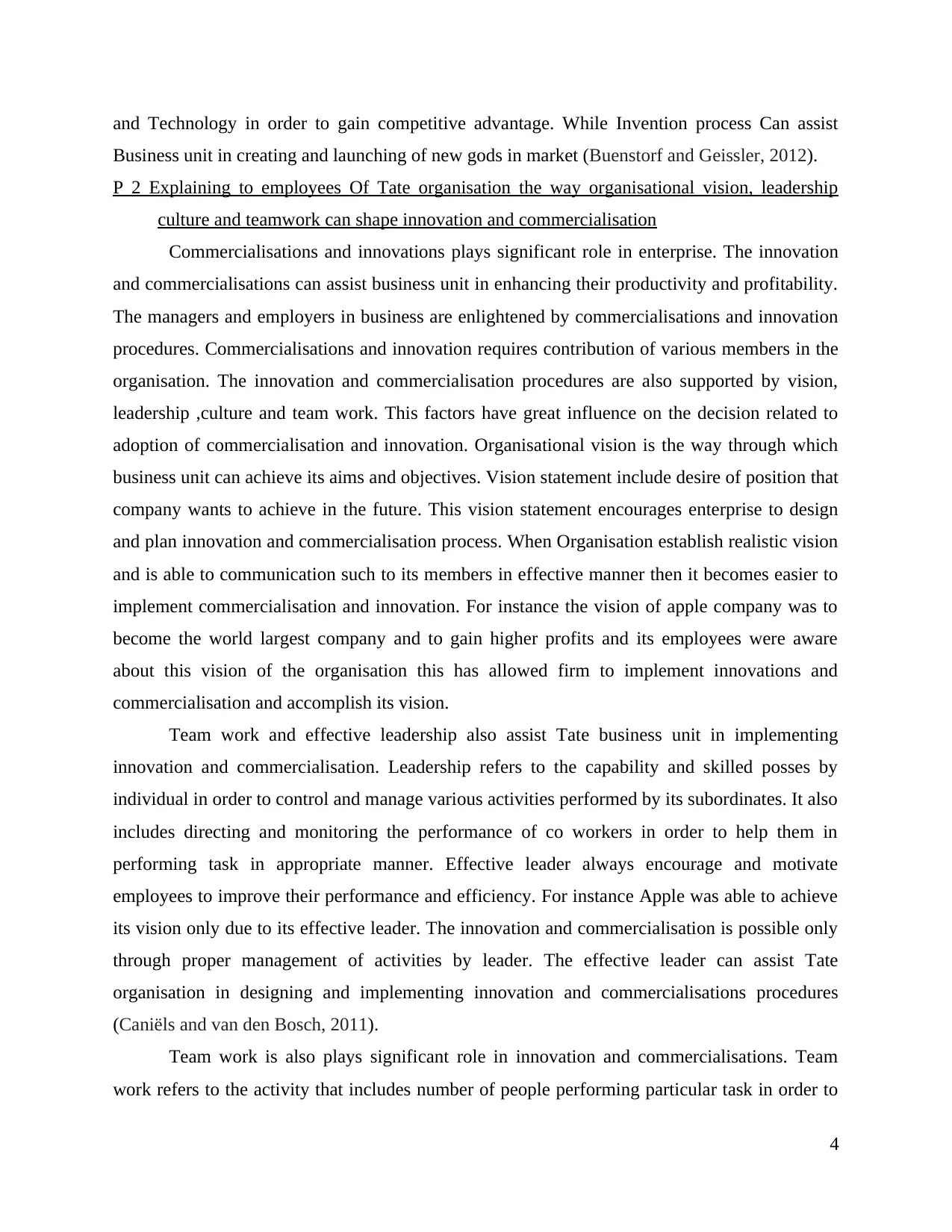
and Technology in order to gain competitive advantage. While Invention process Can assist
Business unit in creating and launching of new gods in market (Buenstorf and Geissler, 2012).
P 2 Explaining to employees Of Tate organisation the way organisational vision, leadership
culture and teamwork can shape innovation and commercialisation
Commercialisations and innovations plays significant role in enterprise. The innovation
and commercialisations can assist business unit in enhancing their productivity and profitability.
The managers and employers in business are enlightened by commercialisations and innovation
procedures. Commercialisations and innovation requires contribution of various members in the
organisation. The innovation and commercialisation procedures are also supported by vision,
leadership ,culture and team work. This factors have great influence on the decision related to
adoption of commercialisation and innovation. Organisational vision is the way through which
business unit can achieve its aims and objectives. Vision statement include desire of position that
company wants to achieve in the future. This vision statement encourages enterprise to design
and plan innovation and commercialisation process. When Organisation establish realistic vision
and is able to communication such to its members in effective manner then it becomes easier to
implement commercialisation and innovation. For instance the vision of apple company was to
become the world largest company and to gain higher profits and its employees were aware
about this vision of the organisation this has allowed firm to implement innovations and
commercialisation and accomplish its vision.
Team work and effective leadership also assist Tate business unit in implementing
innovation and commercialisation. Leadership refers to the capability and skilled posses by
individual in order to control and manage various activities performed by its subordinates. It also
includes directing and monitoring the performance of co workers in order to help them in
performing task in appropriate manner. Effective leader always encourage and motivate
employees to improve their performance and efficiency. For instance Apple was able to achieve
its vision only due to its effective leader. The innovation and commercialisation is possible only
through proper management of activities by leader. The effective leader can assist Tate
organisation in designing and implementing innovation and commercialisations procedures
(Caniëls and van den Bosch, 2011).
Team work is also plays significant role in innovation and commercialisations. Team
work refers to the activity that includes number of people performing particular task in order to
4
Business unit in creating and launching of new gods in market (Buenstorf and Geissler, 2012).
P 2 Explaining to employees Of Tate organisation the way organisational vision, leadership
culture and teamwork can shape innovation and commercialisation
Commercialisations and innovations plays significant role in enterprise. The innovation
and commercialisations can assist business unit in enhancing their productivity and profitability.
The managers and employers in business are enlightened by commercialisations and innovation
procedures. Commercialisations and innovation requires contribution of various members in the
organisation. The innovation and commercialisation procedures are also supported by vision,
leadership ,culture and team work. This factors have great influence on the decision related to
adoption of commercialisation and innovation. Organisational vision is the way through which
business unit can achieve its aims and objectives. Vision statement include desire of position that
company wants to achieve in the future. This vision statement encourages enterprise to design
and plan innovation and commercialisation process. When Organisation establish realistic vision
and is able to communication such to its members in effective manner then it becomes easier to
implement commercialisation and innovation. For instance the vision of apple company was to
become the world largest company and to gain higher profits and its employees were aware
about this vision of the organisation this has allowed firm to implement innovations and
commercialisation and accomplish its vision.
Team work and effective leadership also assist Tate business unit in implementing
innovation and commercialisation. Leadership refers to the capability and skilled posses by
individual in order to control and manage various activities performed by its subordinates. It also
includes directing and monitoring the performance of co workers in order to help them in
performing task in appropriate manner. Effective leader always encourage and motivate
employees to improve their performance and efficiency. For instance Apple was able to achieve
its vision only due to its effective leader. The innovation and commercialisation is possible only
through proper management of activities by leader. The effective leader can assist Tate
organisation in designing and implementing innovation and commercialisations procedures
(Caniëls and van den Bosch, 2011).
Team work is also plays significant role in innovation and commercialisations. Team
work refers to the activity that includes number of people performing particular task in order to
4
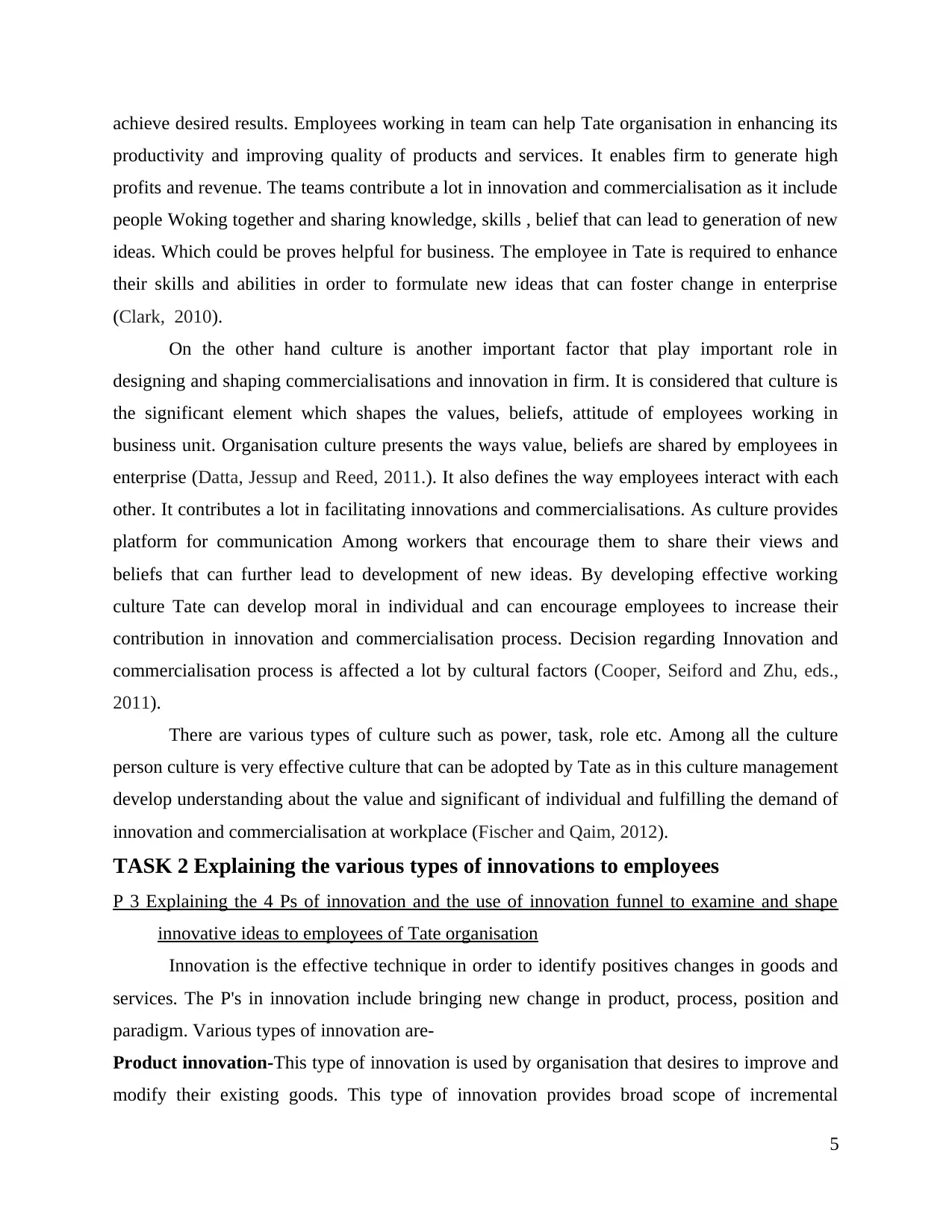
achieve desired results. Employees working in team can help Tate organisation in enhancing its
productivity and improving quality of products and services. It enables firm to generate high
profits and revenue. The teams contribute a lot in innovation and commercialisation as it include
people Woking together and sharing knowledge, skills , belief that can lead to generation of new
ideas. Which could be proves helpful for business. The employee in Tate is required to enhance
their skills and abilities in order to formulate new ideas that can foster change in enterprise
(Clark, 2010).
On the other hand culture is another important factor that play important role in
designing and shaping commercialisations and innovation in firm. It is considered that culture is
the significant element which shapes the values, beliefs, attitude of employees working in
business unit. Organisation culture presents the ways value, beliefs are shared by employees in
enterprise (Datta, Jessup and Reed, 2011.). It also defines the way employees interact with each
other. It contributes a lot in facilitating innovations and commercialisations. As culture provides
platform for communication Among workers that encourage them to share their views and
beliefs that can further lead to development of new ideas. By developing effective working
culture Tate can develop moral in individual and can encourage employees to increase their
contribution in innovation and commercialisation process. Decision regarding Innovation and
commercialisation process is affected a lot by cultural factors (Cooper, Seiford and Zhu, eds.,
2011).
There are various types of culture such as power, task, role etc. Among all the culture
person culture is very effective culture that can be adopted by Tate as in this culture management
develop understanding about the value and significant of individual and fulfilling the demand of
innovation and commercialisation at workplace (Fischer and Qaim, 2012).
TASK 2 Explaining the various types of innovations to employees
P 3 Explaining the 4 Ps of innovation and the use of innovation funnel to examine and shape
innovative ideas to employees of Tate organisation
Innovation is the effective technique in order to identify positives changes in goods and
services. The P's in innovation include bringing new change in product, process, position and
paradigm. Various types of innovation are-
Product innovation-This type of innovation is used by organisation that desires to improve and
modify their existing goods. This type of innovation provides broad scope of incremental
5
productivity and improving quality of products and services. It enables firm to generate high
profits and revenue. The teams contribute a lot in innovation and commercialisation as it include
people Woking together and sharing knowledge, skills , belief that can lead to generation of new
ideas. Which could be proves helpful for business. The employee in Tate is required to enhance
their skills and abilities in order to formulate new ideas that can foster change in enterprise
(Clark, 2010).
On the other hand culture is another important factor that play important role in
designing and shaping commercialisations and innovation in firm. It is considered that culture is
the significant element which shapes the values, beliefs, attitude of employees working in
business unit. Organisation culture presents the ways value, beliefs are shared by employees in
enterprise (Datta, Jessup and Reed, 2011.). It also defines the way employees interact with each
other. It contributes a lot in facilitating innovations and commercialisations. As culture provides
platform for communication Among workers that encourage them to share their views and
beliefs that can further lead to development of new ideas. By developing effective working
culture Tate can develop moral in individual and can encourage employees to increase their
contribution in innovation and commercialisation process. Decision regarding Innovation and
commercialisation process is affected a lot by cultural factors (Cooper, Seiford and Zhu, eds.,
2011).
There are various types of culture such as power, task, role etc. Among all the culture
person culture is very effective culture that can be adopted by Tate as in this culture management
develop understanding about the value and significant of individual and fulfilling the demand of
innovation and commercialisation at workplace (Fischer and Qaim, 2012).
TASK 2 Explaining the various types of innovations to employees
P 3 Explaining the 4 Ps of innovation and the use of innovation funnel to examine and shape
innovative ideas to employees of Tate organisation
Innovation is the effective technique in order to identify positives changes in goods and
services. The P's in innovation include bringing new change in product, process, position and
paradigm. Various types of innovation are-
Product innovation-This type of innovation is used by organisation that desires to improve and
modify their existing goods. This type of innovation provides broad scope of incremental
5
Paraphrase This Document
Need a fresh take? Get an instant paraphrase of this document with our AI Paraphraser
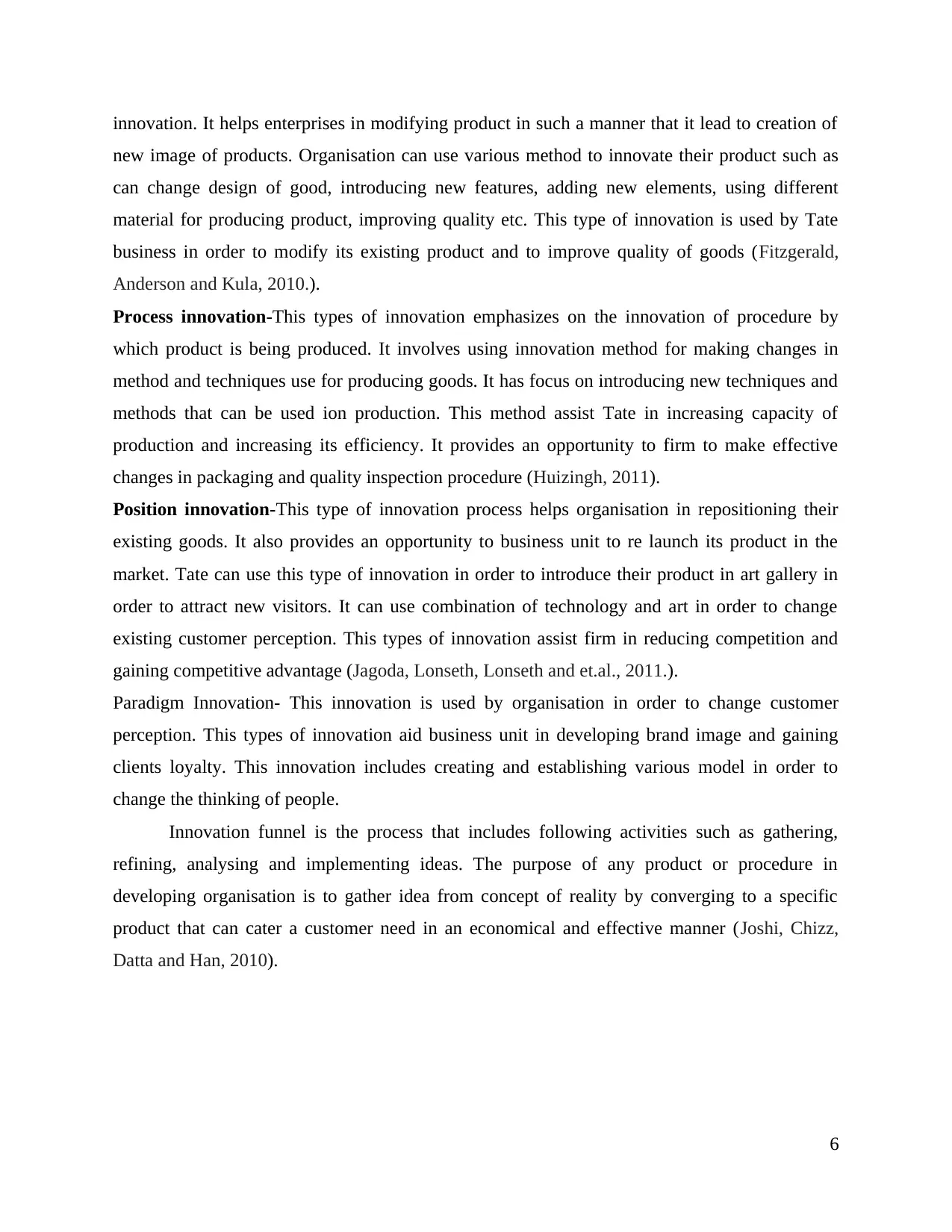
innovation. It helps enterprises in modifying product in such a manner that it lead to creation of
new image of products. Organisation can use various method to innovate their product such as
can change design of good, introducing new features, adding new elements, using different
material for producing product, improving quality etc. This type of innovation is used by Tate
business in order to modify its existing product and to improve quality of goods (Fitzgerald,
Anderson and Kula, 2010.).
Process innovation-This types of innovation emphasizes on the innovation of procedure by
which product is being produced. It involves using innovation method for making changes in
method and techniques use for producing goods. It has focus on introducing new techniques and
methods that can be used ion production. This method assist Tate in increasing capacity of
production and increasing its efficiency. It provides an opportunity to firm to make effective
changes in packaging and quality inspection procedure (Huizingh, 2011).
Position innovation-This type of innovation process helps organisation in repositioning their
existing goods. It also provides an opportunity to business unit to re launch its product in the
market. Tate can use this type of innovation in order to introduce their product in art gallery in
order to attract new visitors. It can use combination of technology and art in order to change
existing customer perception. This types of innovation assist firm in reducing competition and
gaining competitive advantage (Jagoda, Lonseth, Lonseth and et.al., 2011.).
Paradigm Innovation- This innovation is used by organisation in order to change customer
perception. This types of innovation aid business unit in developing brand image and gaining
clients loyalty. This innovation includes creating and establishing various model in order to
change the thinking of people.
Innovation funnel is the process that includes following activities such as gathering,
refining, analysing and implementing ideas. The purpose of any product or procedure in
developing organisation is to gather idea from concept of reality by converging to a specific
product that can cater a customer need in an economical and effective manner (Joshi, Chizz,
Datta and Han, 2010).
6
new image of products. Organisation can use various method to innovate their product such as
can change design of good, introducing new features, adding new elements, using different
material for producing product, improving quality etc. This type of innovation is used by Tate
business in order to modify its existing product and to improve quality of goods (Fitzgerald,
Anderson and Kula, 2010.).
Process innovation-This types of innovation emphasizes on the innovation of procedure by
which product is being produced. It involves using innovation method for making changes in
method and techniques use for producing goods. It has focus on introducing new techniques and
methods that can be used ion production. This method assist Tate in increasing capacity of
production and increasing its efficiency. It provides an opportunity to firm to make effective
changes in packaging and quality inspection procedure (Huizingh, 2011).
Position innovation-This type of innovation process helps organisation in repositioning their
existing goods. It also provides an opportunity to business unit to re launch its product in the
market. Tate can use this type of innovation in order to introduce their product in art gallery in
order to attract new visitors. It can use combination of technology and art in order to change
existing customer perception. This types of innovation assist firm in reducing competition and
gaining competitive advantage (Jagoda, Lonseth, Lonseth and et.al., 2011.).
Paradigm Innovation- This innovation is used by organisation in order to change customer
perception. This types of innovation aid business unit in developing brand image and gaining
clients loyalty. This innovation includes creating and establishing various model in order to
change the thinking of people.
Innovation funnel is the process that includes following activities such as gathering,
refining, analysing and implementing ideas. The purpose of any product or procedure in
developing organisation is to gather idea from concept of reality by converging to a specific
product that can cater a customer need in an economical and effective manner (Joshi, Chizz,
Datta and Han, 2010).
6
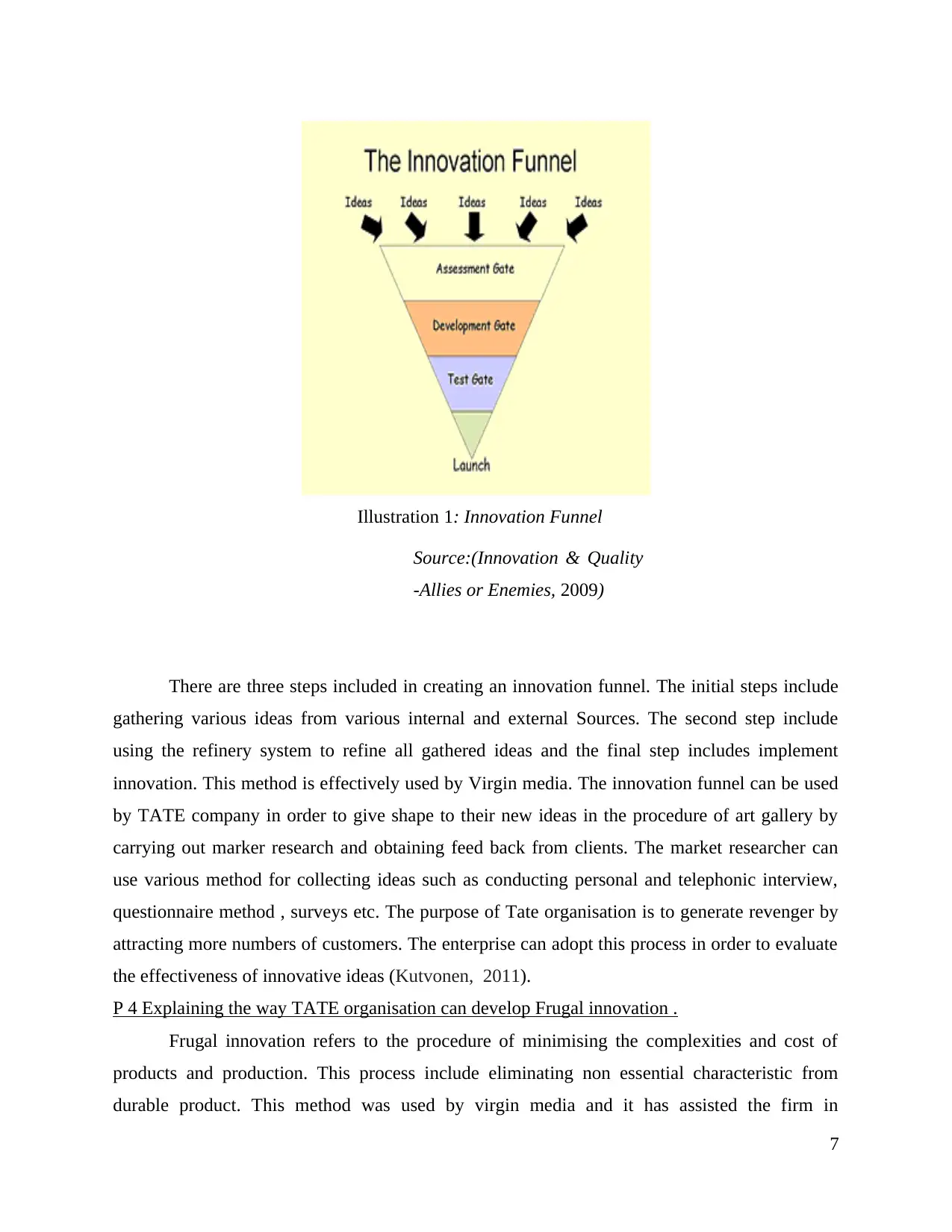
There are three steps included in creating an innovation funnel. The initial steps include
gathering various ideas from various internal and external Sources. The second step include
using the refinery system to refine all gathered ideas and the final step includes implement
innovation. This method is effectively used by Virgin media. The innovation funnel can be used
by TATE company in order to give shape to their new ideas in the procedure of art gallery by
carrying out marker research and obtaining feed back from clients. The market researcher can
use various method for collecting ideas such as conducting personal and telephonic interview,
questionnaire method , surveys etc. The purpose of Tate organisation is to generate revenger by
attracting more numbers of customers. The enterprise can adopt this process in order to evaluate
the effectiveness of innovative ideas (Kutvonen, 2011).
P 4 Explaining the way TATE organisation can develop Frugal innovation .
Frugal innovation refers to the procedure of minimising the complexities and cost of
products and production. This process include eliminating non essential characteristic from
durable product. This method was used by virgin media and it has assisted the firm in
7
Illustration 1: Innovation Funnel
Source:(Innovation & Quality
-Allies or Enemies, 2009)
gathering various ideas from various internal and external Sources. The second step include
using the refinery system to refine all gathered ideas and the final step includes implement
innovation. This method is effectively used by Virgin media. The innovation funnel can be used
by TATE company in order to give shape to their new ideas in the procedure of art gallery by
carrying out marker research and obtaining feed back from clients. The market researcher can
use various method for collecting ideas such as conducting personal and telephonic interview,
questionnaire method , surveys etc. The purpose of Tate organisation is to generate revenger by
attracting more numbers of customers. The enterprise can adopt this process in order to evaluate
the effectiveness of innovative ideas (Kutvonen, 2011).
P 4 Explaining the way TATE organisation can develop Frugal innovation .
Frugal innovation refers to the procedure of minimising the complexities and cost of
products and production. This process include eliminating non essential characteristic from
durable product. This method was used by virgin media and it has assisted the firm in
7
Illustration 1: Innovation Funnel
Source:(Innovation & Quality
-Allies or Enemies, 2009)
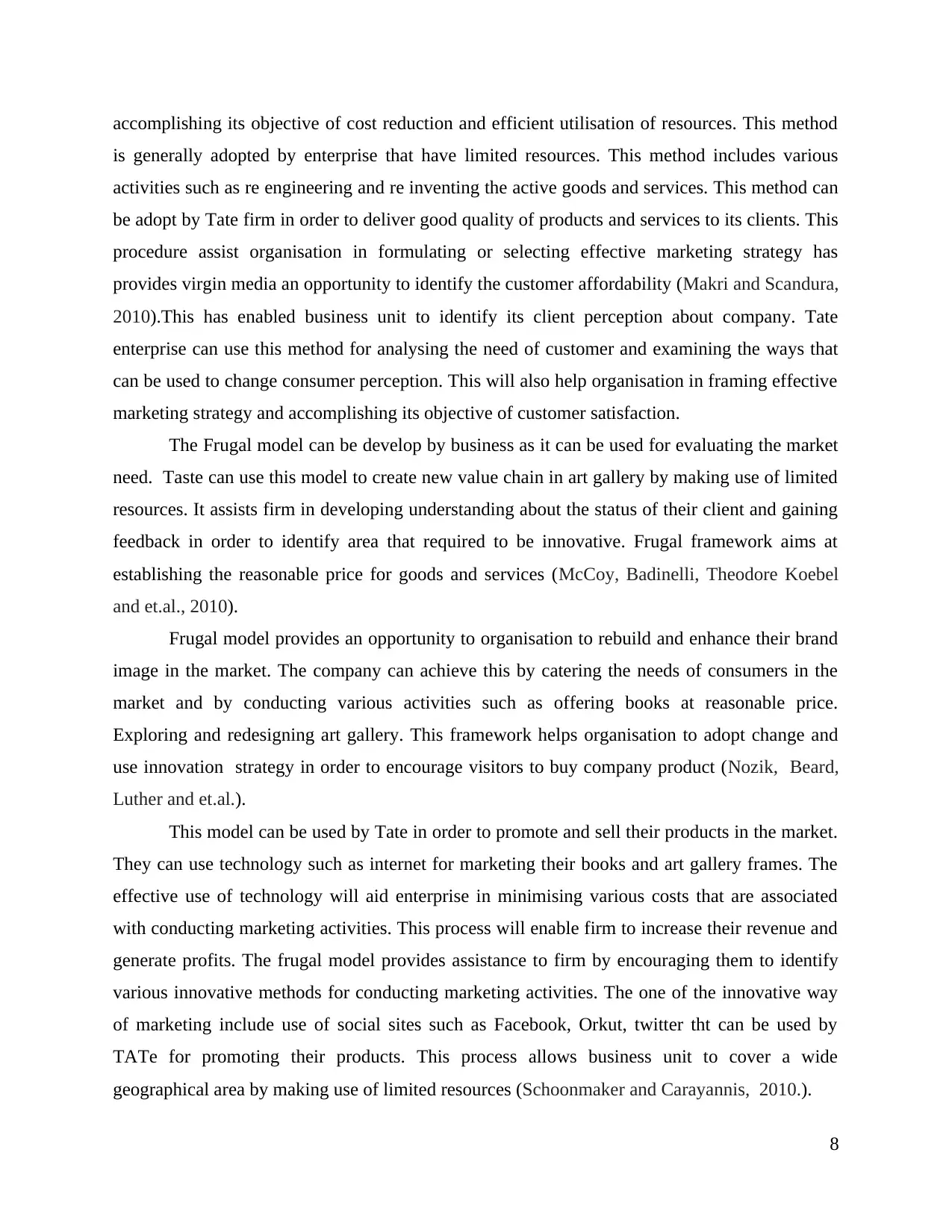
accomplishing its objective of cost reduction and efficient utilisation of resources. This method
is generally adopted by enterprise that have limited resources. This method includes various
activities such as re engineering and re inventing the active goods and services. This method can
be adopt by Tate firm in order to deliver good quality of products and services to its clients. This
procedure assist organisation in formulating or selecting effective marketing strategy has
provides virgin media an opportunity to identify the customer affordability (Makri and Scandura,
2010).This has enabled business unit to identify its client perception about company. Tate
enterprise can use this method for analysing the need of customer and examining the ways that
can be used to change consumer perception. This will also help organisation in framing effective
marketing strategy and accomplishing its objective of customer satisfaction.
The Frugal model can be develop by business as it can be used for evaluating the market
need. Taste can use this model to create new value chain in art gallery by making use of limited
resources. It assists firm in developing understanding about the status of their client and gaining
feedback in order to identify area that required to be innovative. Frugal framework aims at
establishing the reasonable price for goods and services (McCoy, Badinelli, Theodore Koebel
and et.al., 2010).
Frugal model provides an opportunity to organisation to rebuild and enhance their brand
image in the market. The company can achieve this by catering the needs of consumers in the
market and by conducting various activities such as offering books at reasonable price.
Exploring and redesigning art gallery. This framework helps organisation to adopt change and
use innovation strategy in order to encourage visitors to buy company product (Nozik, Beard,
Luther and et.al.).
This model can be used by Tate in order to promote and sell their products in the market.
They can use technology such as internet for marketing their books and art gallery frames. The
effective use of technology will aid enterprise in minimising various costs that are associated
with conducting marketing activities. This process will enable firm to increase their revenue and
generate profits. The frugal model provides assistance to firm by encouraging them to identify
various innovative methods for conducting marketing activities. The one of the innovative way
of marketing include use of social sites such as Facebook, Orkut, twitter tht can be used by
TATe for promoting their products. This process allows business unit to cover a wide
geographical area by making use of limited resources (Schoonmaker and Carayannis, 2010.).
8
is generally adopted by enterprise that have limited resources. This method includes various
activities such as re engineering and re inventing the active goods and services. This method can
be adopt by Tate firm in order to deliver good quality of products and services to its clients. This
procedure assist organisation in formulating or selecting effective marketing strategy has
provides virgin media an opportunity to identify the customer affordability (Makri and Scandura,
2010).This has enabled business unit to identify its client perception about company. Tate
enterprise can use this method for analysing the need of customer and examining the ways that
can be used to change consumer perception. This will also help organisation in framing effective
marketing strategy and accomplishing its objective of customer satisfaction.
The Frugal model can be develop by business as it can be used for evaluating the market
need. Taste can use this model to create new value chain in art gallery by making use of limited
resources. It assists firm in developing understanding about the status of their client and gaining
feedback in order to identify area that required to be innovative. Frugal framework aims at
establishing the reasonable price for goods and services (McCoy, Badinelli, Theodore Koebel
and et.al., 2010).
Frugal model provides an opportunity to organisation to rebuild and enhance their brand
image in the market. The company can achieve this by catering the needs of consumers in the
market and by conducting various activities such as offering books at reasonable price.
Exploring and redesigning art gallery. This framework helps organisation to adopt change and
use innovation strategy in order to encourage visitors to buy company product (Nozik, Beard,
Luther and et.al.).
This model can be used by Tate in order to promote and sell their products in the market.
They can use technology such as internet for marketing their books and art gallery frames. The
effective use of technology will aid enterprise in minimising various costs that are associated
with conducting marketing activities. This process will enable firm to increase their revenue and
generate profits. The frugal model provides assistance to firm by encouraging them to identify
various innovative methods for conducting marketing activities. The one of the innovative way
of marketing include use of social sites such as Facebook, Orkut, twitter tht can be used by
TATe for promoting their products. This process allows business unit to cover a wide
geographical area by making use of limited resources (Schoonmaker and Carayannis, 2010.).
8
Secure Best Marks with AI Grader
Need help grading? Try our AI Grader for instant feedback on your assignments.
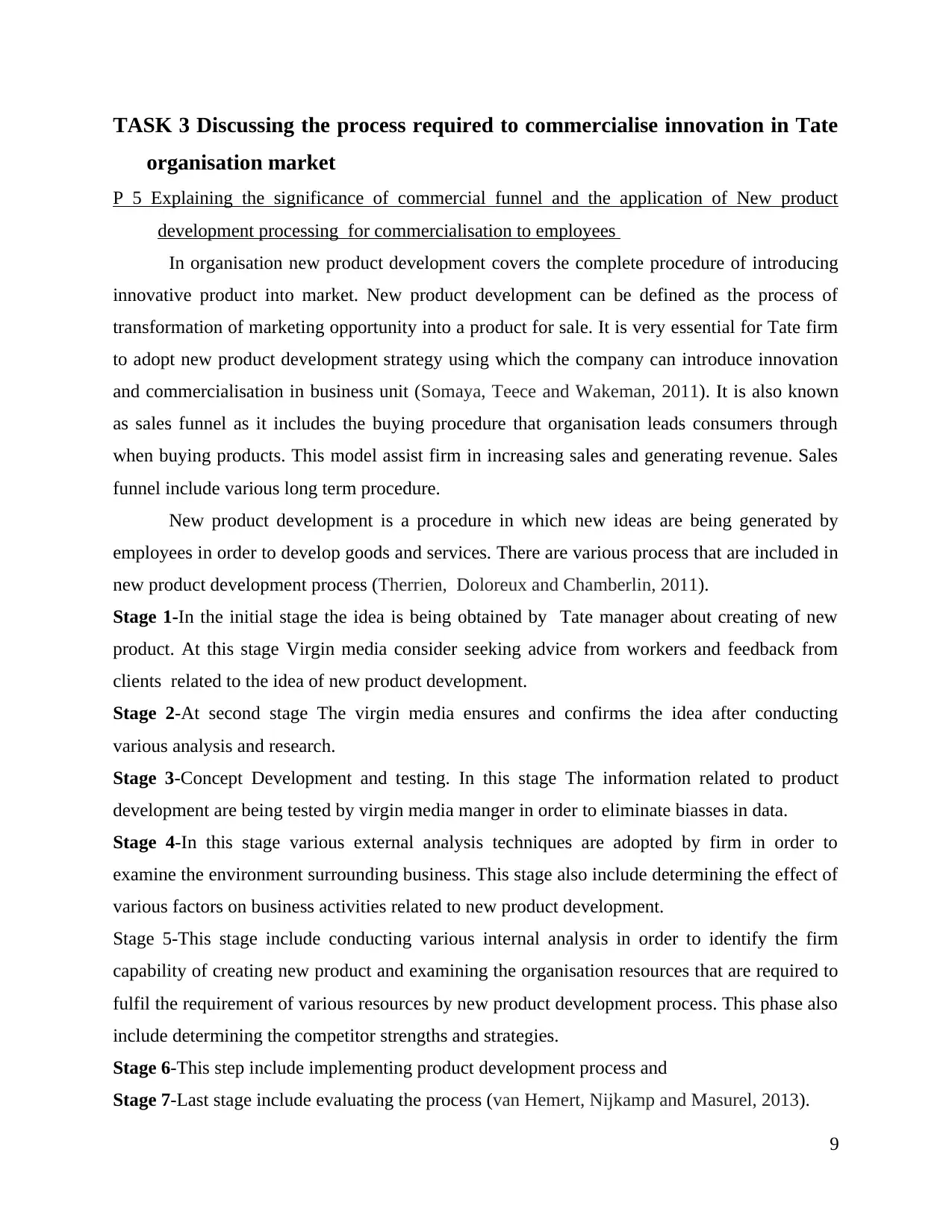
TASK 3 Discussing the process required to commercialise innovation in Tate
organisation market
P 5 Explaining the significance of commercial funnel and the application of New product
development processing for commercialisation to employees
In organisation new product development covers the complete procedure of introducing
innovative product into market. New product development can be defined as the process of
transformation of marketing opportunity into a product for sale. It is very essential for Tate firm
to adopt new product development strategy using which the company can introduce innovation
and commercialisation in business unit (Somaya, Teece and Wakeman, 2011). It is also known
as sales funnel as it includes the buying procedure that organisation leads consumers through
when buying products. This model assist firm in increasing sales and generating revenue. Sales
funnel include various long term procedure.
New product development is a procedure in which new ideas are being generated by
employees in order to develop goods and services. There are various process that are included in
new product development process (Therrien, Doloreux and Chamberlin, 2011).
Stage 1-In the initial stage the idea is being obtained by Tate manager about creating of new
product. At this stage Virgin media consider seeking advice from workers and feedback from
clients related to the idea of new product development.
Stage 2-At second stage The virgin media ensures and confirms the idea after conducting
various analysis and research.
Stage 3-Concept Development and testing. In this stage The information related to product
development are being tested by virgin media manger in order to eliminate biasses in data.
Stage 4-In this stage various external analysis techniques are adopted by firm in order to
examine the environment surrounding business. This stage also include determining the effect of
various factors on business activities related to new product development.
Stage 5-This stage include conducting various internal analysis in order to identify the firm
capability of creating new product and examining the organisation resources that are required to
fulfil the requirement of various resources by new product development process. This phase also
include determining the competitor strengths and strategies.
Stage 6-This step include implementing product development process and
Stage 7-Last stage include evaluating the process (van Hemert, Nijkamp and Masurel, 2013).
9
organisation market
P 5 Explaining the significance of commercial funnel and the application of New product
development processing for commercialisation to employees
In organisation new product development covers the complete procedure of introducing
innovative product into market. New product development can be defined as the process of
transformation of marketing opportunity into a product for sale. It is very essential for Tate firm
to adopt new product development strategy using which the company can introduce innovation
and commercialisation in business unit (Somaya, Teece and Wakeman, 2011). It is also known
as sales funnel as it includes the buying procedure that organisation leads consumers through
when buying products. This model assist firm in increasing sales and generating revenue. Sales
funnel include various long term procedure.
New product development is a procedure in which new ideas are being generated by
employees in order to develop goods and services. There are various process that are included in
new product development process (Therrien, Doloreux and Chamberlin, 2011).
Stage 1-In the initial stage the idea is being obtained by Tate manager about creating of new
product. At this stage Virgin media consider seeking advice from workers and feedback from
clients related to the idea of new product development.
Stage 2-At second stage The virgin media ensures and confirms the idea after conducting
various analysis and research.
Stage 3-Concept Development and testing. In this stage The information related to product
development are being tested by virgin media manger in order to eliminate biasses in data.
Stage 4-In this stage various external analysis techniques are adopted by firm in order to
examine the environment surrounding business. This stage also include determining the effect of
various factors on business activities related to new product development.
Stage 5-This stage include conducting various internal analysis in order to identify the firm
capability of creating new product and examining the organisation resources that are required to
fulfil the requirement of various resources by new product development process. This phase also
include determining the competitor strengths and strategies.
Stage 6-This step include implementing product development process and
Stage 7-Last stage include evaluating the process (van Hemert, Nijkamp and Masurel, 2013).
9
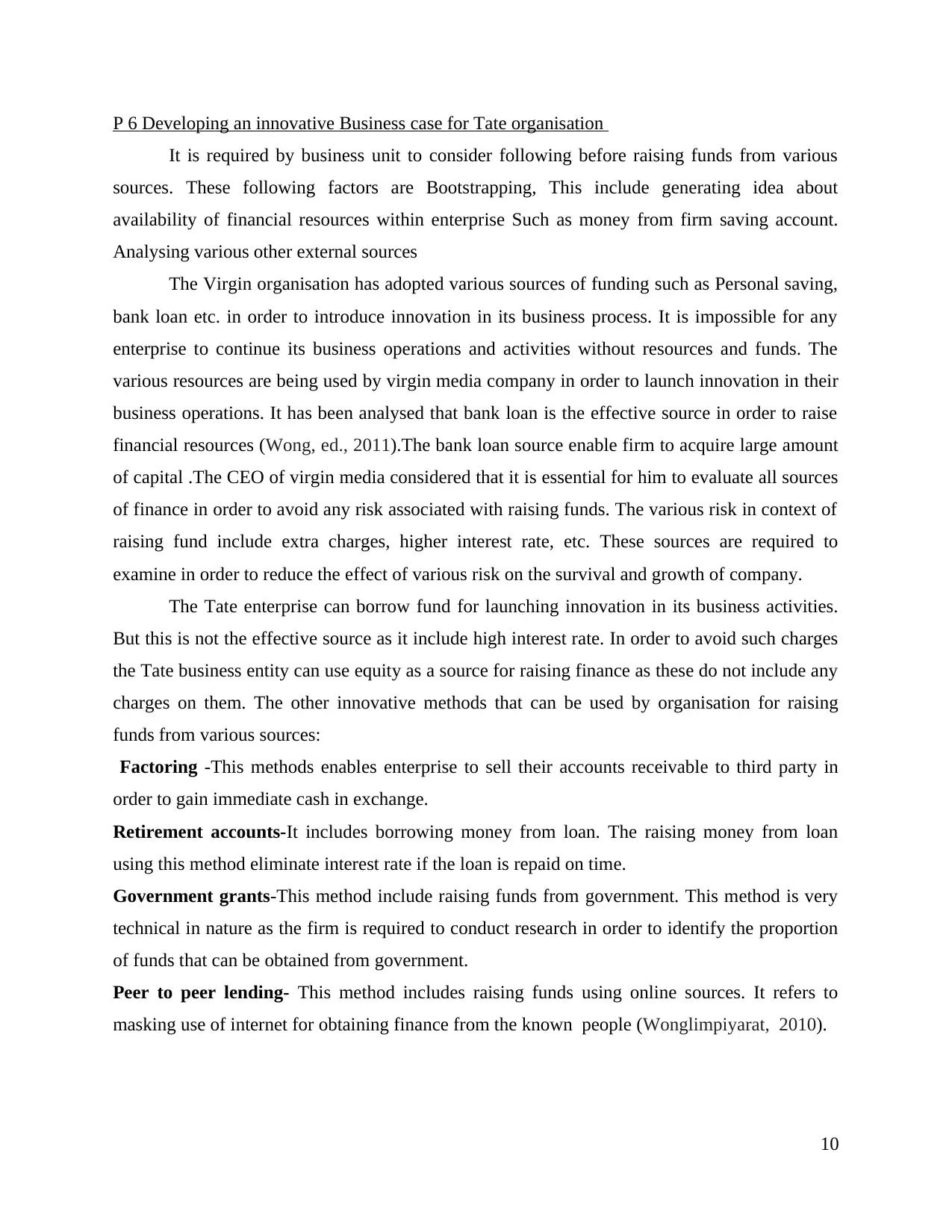
P 6 Developing an innovative Business case for Tate organisation
It is required by business unit to consider following before raising funds from various
sources. These following factors are Bootstrapping, This include generating idea about
availability of financial resources within enterprise Such as money from firm saving account.
Analysing various other external sources
The Virgin organisation has adopted various sources of funding such as Personal saving,
bank loan etc. in order to introduce innovation in its business process. It is impossible for any
enterprise to continue its business operations and activities without resources and funds. The
various resources are being used by virgin media company in order to launch innovation in their
business operations. It has been analysed that bank loan is the effective source in order to raise
financial resources (Wong, ed., 2011).The bank loan source enable firm to acquire large amount
of capital .The CEO of virgin media considered that it is essential for him to evaluate all sources
of finance in order to avoid any risk associated with raising funds. The various risk in context of
raising fund include extra charges, higher interest rate, etc. These sources are required to
examine in order to reduce the effect of various risk on the survival and growth of company.
The Tate enterprise can borrow fund for launching innovation in its business activities.
But this is not the effective source as it include high interest rate. In order to avoid such charges
the Tate business entity can use equity as a source for raising finance as these do not include any
charges on them. The other innovative methods that can be used by organisation for raising
funds from various sources:
Factoring -This methods enables enterprise to sell their accounts receivable to third party in
order to gain immediate cash in exchange.
Retirement accounts-It includes borrowing money from loan. The raising money from loan
using this method eliminate interest rate if the loan is repaid on time.
Government grants-This method include raising funds from government. This method is very
technical in nature as the firm is required to conduct research in order to identify the proportion
of funds that can be obtained from government.
Peer to peer lending- This method includes raising funds using online sources. It refers to
masking use of internet for obtaining finance from the known people (Wonglimpiyarat, 2010).
10
It is required by business unit to consider following before raising funds from various
sources. These following factors are Bootstrapping, This include generating idea about
availability of financial resources within enterprise Such as money from firm saving account.
Analysing various other external sources
The Virgin organisation has adopted various sources of funding such as Personal saving,
bank loan etc. in order to introduce innovation in its business process. It is impossible for any
enterprise to continue its business operations and activities without resources and funds. The
various resources are being used by virgin media company in order to launch innovation in their
business operations. It has been analysed that bank loan is the effective source in order to raise
financial resources (Wong, ed., 2011).The bank loan source enable firm to acquire large amount
of capital .The CEO of virgin media considered that it is essential for him to evaluate all sources
of finance in order to avoid any risk associated with raising funds. The various risk in context of
raising fund include extra charges, higher interest rate, etc. These sources are required to
examine in order to reduce the effect of various risk on the survival and growth of company.
The Tate enterprise can borrow fund for launching innovation in its business activities.
But this is not the effective source as it include high interest rate. In order to avoid such charges
the Tate business entity can use equity as a source for raising finance as these do not include any
charges on them. The other innovative methods that can be used by organisation for raising
funds from various sources:
Factoring -This methods enables enterprise to sell their accounts receivable to third party in
order to gain immediate cash in exchange.
Retirement accounts-It includes borrowing money from loan. The raising money from loan
using this method eliminate interest rate if the loan is repaid on time.
Government grants-This method include raising funds from government. This method is very
technical in nature as the firm is required to conduct research in order to identify the proportion
of funds that can be obtained from government.
Peer to peer lending- This method includes raising funds using online sources. It refers to
masking use of internet for obtaining finance from the known people (Wonglimpiyarat, 2010).
10
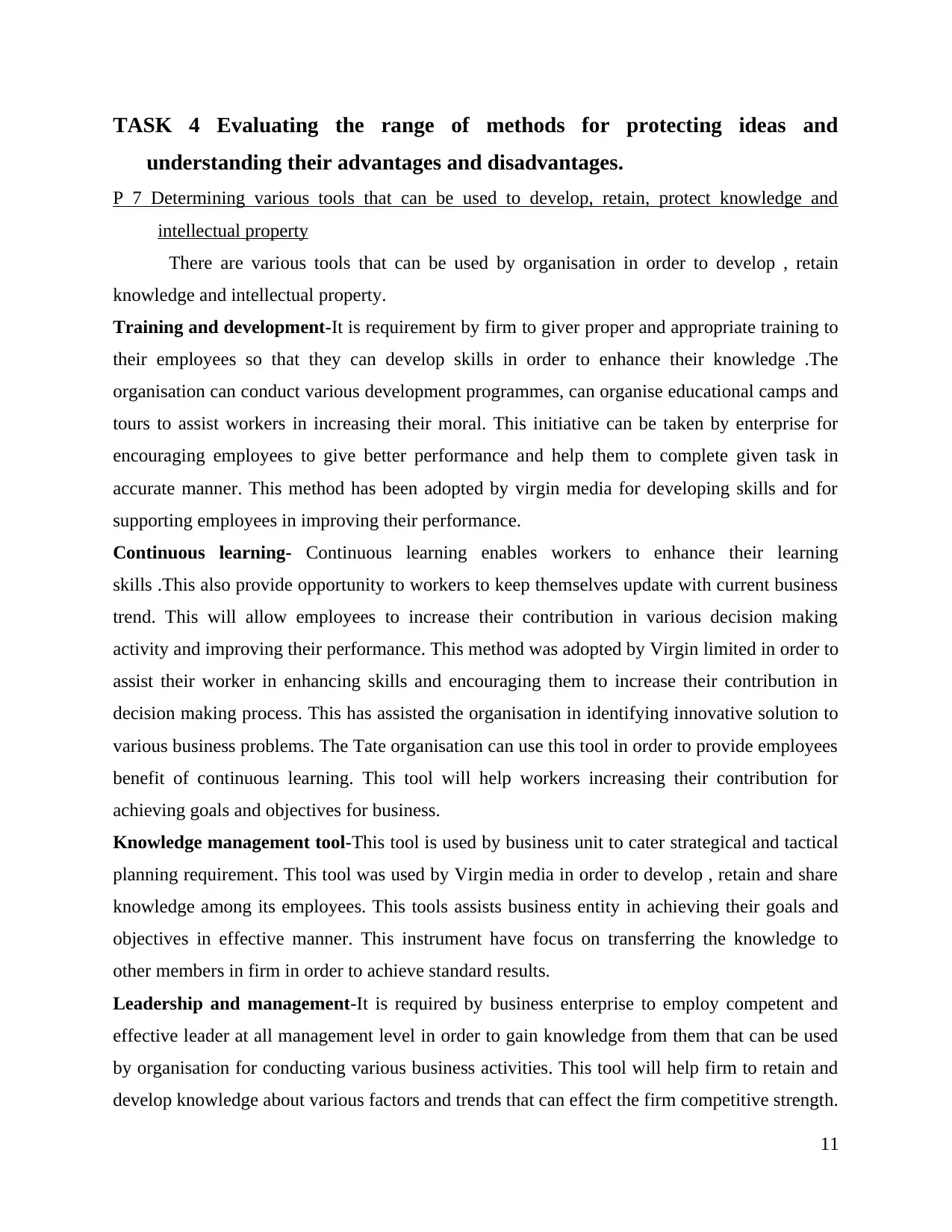
TASK 4 Evaluating the range of methods for protecting ideas and
understanding their advantages and disadvantages.
P 7 Determining various tools that can be used to develop, retain, protect knowledge and
intellectual property
There are various tools that can be used by organisation in order to develop , retain
knowledge and intellectual property.
Training and development-It is requirement by firm to giver proper and appropriate training to
their employees so that they can develop skills in order to enhance their knowledge .The
organisation can conduct various development programmes, can organise educational camps and
tours to assist workers in increasing their moral. This initiative can be taken by enterprise for
encouraging employees to give better performance and help them to complete given task in
accurate manner. This method has been adopted by virgin media for developing skills and for
supporting employees in improving their performance.
Continuous learning- Continuous learning enables workers to enhance their learning
skills .This also provide opportunity to workers to keep themselves update with current business
trend. This will allow employees to increase their contribution in various decision making
activity and improving their performance. This method was adopted by Virgin limited in order to
assist their worker in enhancing skills and encouraging them to increase their contribution in
decision making process. This has assisted the organisation in identifying innovative solution to
various business problems. The Tate organisation can use this tool in order to provide employees
benefit of continuous learning. This tool will help workers increasing their contribution for
achieving goals and objectives for business.
Knowledge management tool-This tool is used by business unit to cater strategical and tactical
planning requirement. This tool was used by Virgin media in order to develop , retain and share
knowledge among its employees. This tools assists business entity in achieving their goals and
objectives in effective manner. This instrument have focus on transferring the knowledge to
other members in firm in order to achieve standard results.
Leadership and management-It is required by business enterprise to employ competent and
effective leader at all management level in order to gain knowledge from them that can be used
by organisation for conducting various business activities. This tool will help firm to retain and
develop knowledge about various factors and trends that can effect the firm competitive strength.
11
understanding their advantages and disadvantages.
P 7 Determining various tools that can be used to develop, retain, protect knowledge and
intellectual property
There are various tools that can be used by organisation in order to develop , retain
knowledge and intellectual property.
Training and development-It is requirement by firm to giver proper and appropriate training to
their employees so that they can develop skills in order to enhance their knowledge .The
organisation can conduct various development programmes, can organise educational camps and
tours to assist workers in increasing their moral. This initiative can be taken by enterprise for
encouraging employees to give better performance and help them to complete given task in
accurate manner. This method has been adopted by virgin media for developing skills and for
supporting employees in improving their performance.
Continuous learning- Continuous learning enables workers to enhance their learning
skills .This also provide opportunity to workers to keep themselves update with current business
trend. This will allow employees to increase their contribution in various decision making
activity and improving their performance. This method was adopted by Virgin limited in order to
assist their worker in enhancing skills and encouraging them to increase their contribution in
decision making process. This has assisted the organisation in identifying innovative solution to
various business problems. The Tate organisation can use this tool in order to provide employees
benefit of continuous learning. This tool will help workers increasing their contribution for
achieving goals and objectives for business.
Knowledge management tool-This tool is used by business unit to cater strategical and tactical
planning requirement. This tool was used by Virgin media in order to develop , retain and share
knowledge among its employees. This tools assists business entity in achieving their goals and
objectives in effective manner. This instrument have focus on transferring the knowledge to
other members in firm in order to achieve standard results.
Leadership and management-It is required by business enterprise to employ competent and
effective leader at all management level in order to gain knowledge from them that can be used
by organisation for conducting various business activities. This tool will help firm to retain and
develop knowledge about various factors and trends that can effect the firm competitive strength.
11
Paraphrase This Document
Need a fresh take? Get an instant paraphrase of this document with our AI Paraphraser
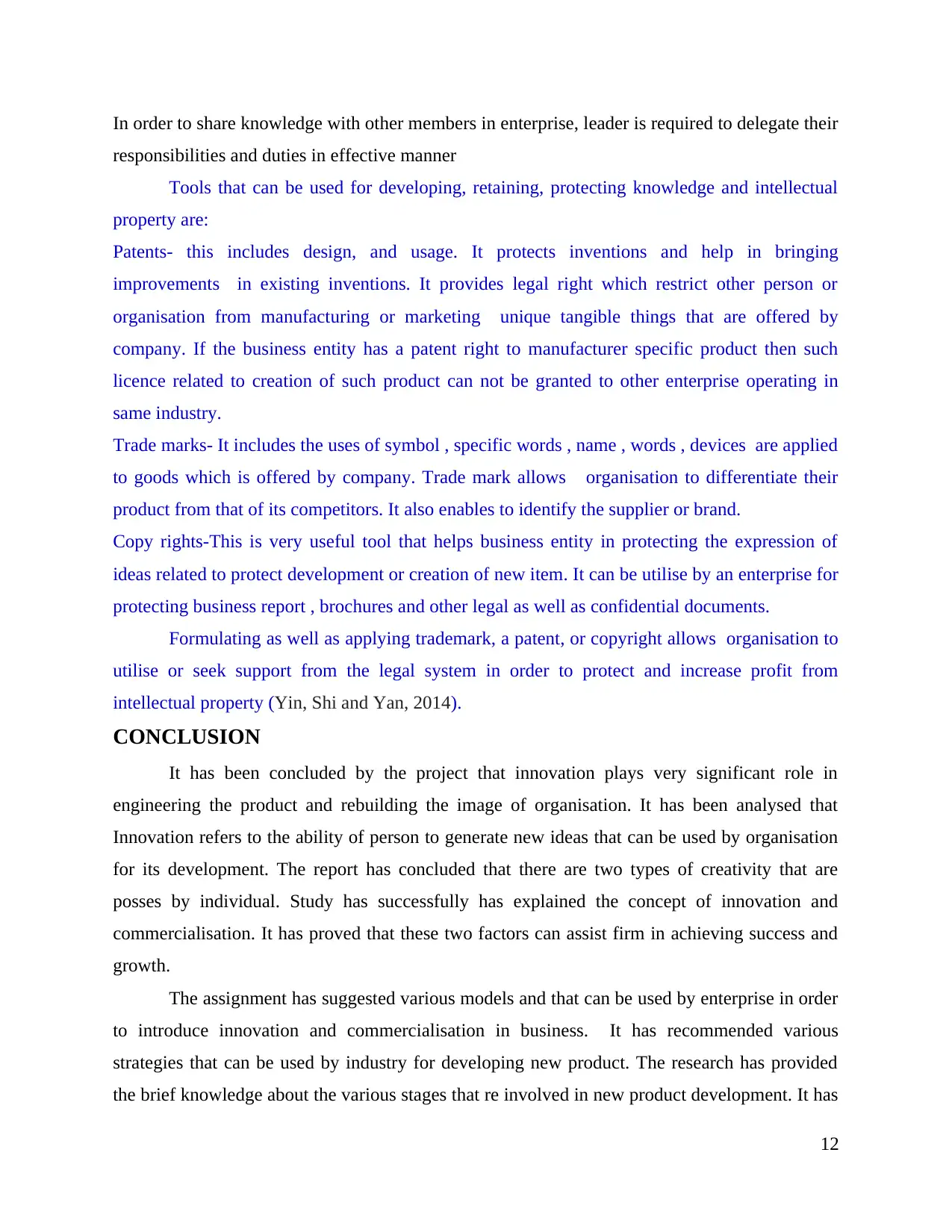
In order to share knowledge with other members in enterprise, leader is required to delegate their
responsibilities and duties in effective manner
Tools that can be used for developing, retaining, protecting knowledge and intellectual
property are:
Patents- this includes design, and usage. It protects inventions and help in bringing
improvements in existing inventions. It provides legal right which restrict other person or
organisation from manufacturing or marketing unique tangible things that are offered by
company. If the business entity has a patent right to manufacturer specific product then such
licence related to creation of such product can not be granted to other enterprise operating in
same industry.
Trade marks- It includes the uses of symbol , specific words , name , words , devices are applied
to goods which is offered by company. Trade mark allows organisation to differentiate their
product from that of its competitors. It also enables to identify the supplier or brand.
Copy rights-This is very useful tool that helps business entity in protecting the expression of
ideas related to protect development or creation of new item. It can be utilise by an enterprise for
protecting business report , brochures and other legal as well as confidential documents.
Formulating as well as applying trademark, a patent, or copyright allows organisation to
utilise or seek support from the legal system in order to protect and increase profit from
intellectual property (Yin, Shi and Yan, 2014).
CONCLUSION
It has been concluded by the project that innovation plays very significant role in
engineering the product and rebuilding the image of organisation. It has been analysed that
Innovation refers to the ability of person to generate new ideas that can be used by organisation
for its development. The report has concluded that there are two types of creativity that are
posses by individual. Study has successfully has explained the concept of innovation and
commercialisation. It has proved that these two factors can assist firm in achieving success and
growth.
The assignment has suggested various models and that can be used by enterprise in order
to introduce innovation and commercialisation in business. It has recommended various
strategies that can be used by industry for developing new product. The research has provided
the brief knowledge about the various stages that re involved in new product development. It has
12
responsibilities and duties in effective manner
Tools that can be used for developing, retaining, protecting knowledge and intellectual
property are:
Patents- this includes design, and usage. It protects inventions and help in bringing
improvements in existing inventions. It provides legal right which restrict other person or
organisation from manufacturing or marketing unique tangible things that are offered by
company. If the business entity has a patent right to manufacturer specific product then such
licence related to creation of such product can not be granted to other enterprise operating in
same industry.
Trade marks- It includes the uses of symbol , specific words , name , words , devices are applied
to goods which is offered by company. Trade mark allows organisation to differentiate their
product from that of its competitors. It also enables to identify the supplier or brand.
Copy rights-This is very useful tool that helps business entity in protecting the expression of
ideas related to protect development or creation of new item. It can be utilise by an enterprise for
protecting business report , brochures and other legal as well as confidential documents.
Formulating as well as applying trademark, a patent, or copyright allows organisation to
utilise or seek support from the legal system in order to protect and increase profit from
intellectual property (Yin, Shi and Yan, 2014).
CONCLUSION
It has been concluded by the project that innovation plays very significant role in
engineering the product and rebuilding the image of organisation. It has been analysed that
Innovation refers to the ability of person to generate new ideas that can be used by organisation
for its development. The report has concluded that there are two types of creativity that are
posses by individual. Study has successfully has explained the concept of innovation and
commercialisation. It has proved that these two factors can assist firm in achieving success and
growth.
The assignment has suggested various models and that can be used by enterprise in order
to introduce innovation and commercialisation in business. It has recommended various
strategies that can be used by industry for developing new product. The research has provided
the brief knowledge about the various stages that re involved in new product development. It has
12
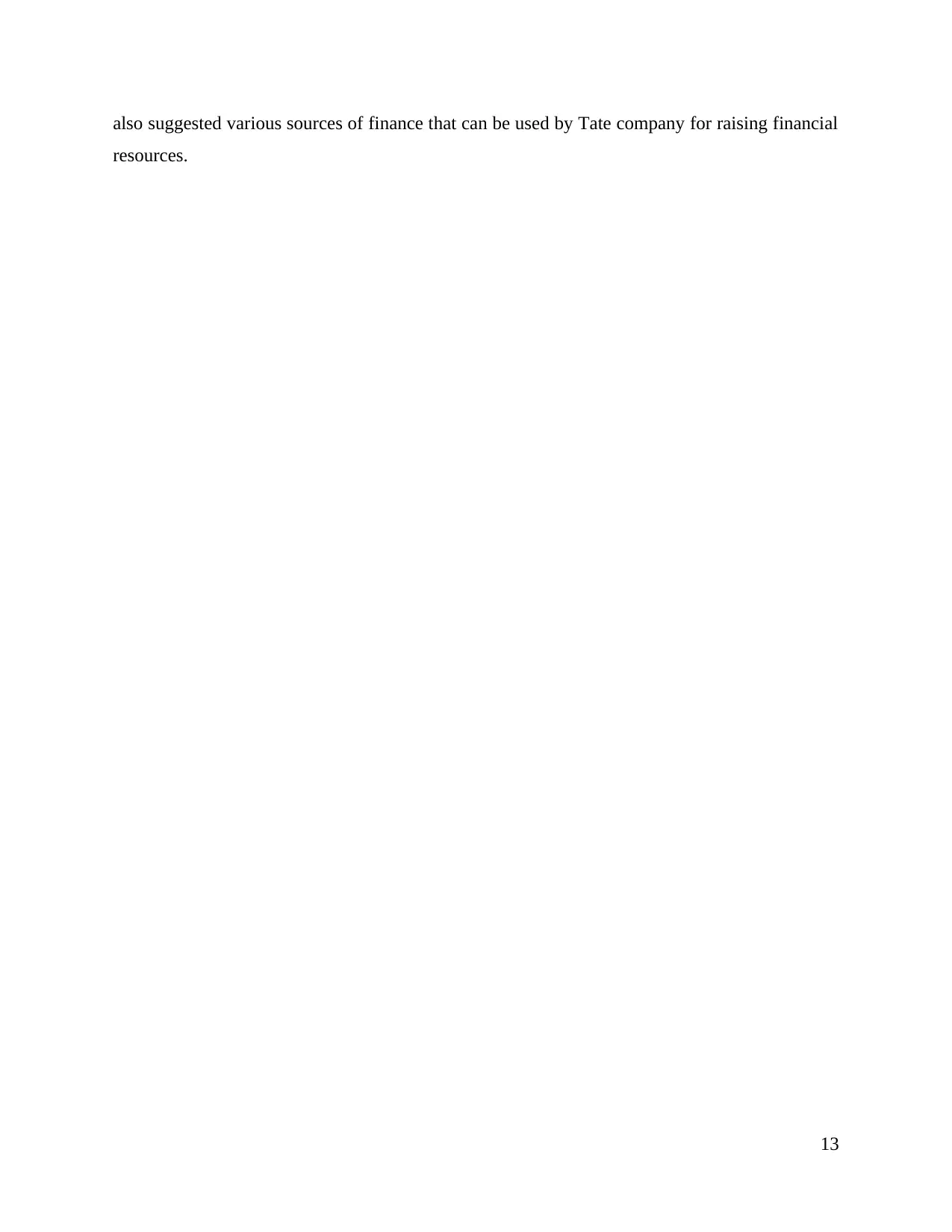
also suggested various sources of finance that can be used by Tate company for raising financial
resources.
13
resources.
13
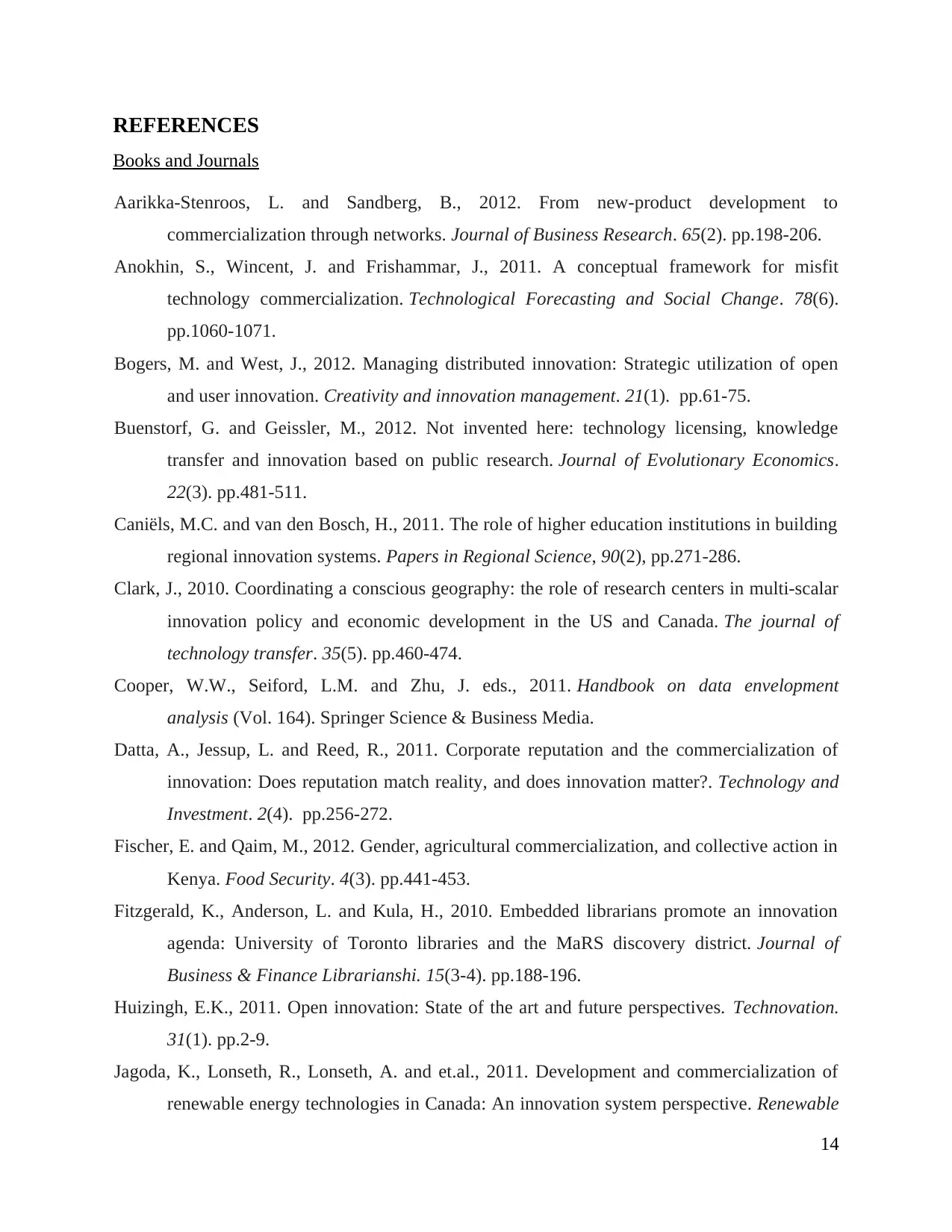
REFERENCES
Books and Journals
Aarikka-Stenroos, L. and Sandberg, B., 2012. From new-product development to
commercialization through networks. Journal of Business Research. 65(2). pp.198-206.
Anokhin, S., Wincent, J. and Frishammar, J., 2011. A conceptual framework for misfit
technology commercialization. Technological Forecasting and Social Change. 78(6).
pp.1060-1071.
Bogers, M. and West, J., 2012. Managing distributed innovation: Strategic utilization of open
and user innovation. Creativity and innovation management. 21(1). pp.61-75.
Buenstorf, G. and Geissler, M., 2012. Not invented here: technology licensing, knowledge
transfer and innovation based on public research. Journal of Evolutionary Economics.
22(3). pp.481-511.
Caniëls, M.C. and van den Bosch, H., 2011. The role of higher education institutions in building
regional innovation systems. Papers in Regional Science, 90(2), pp.271-286.
Clark, J., 2010. Coordinating a conscious geography: the role of research centers in multi-scalar
innovation policy and economic development in the US and Canada. The journal of
technology transfer. 35(5). pp.460-474.
Cooper, W.W., Seiford, L.M. and Zhu, J. eds., 2011. Handbook on data envelopment
analysis (Vol. 164). Springer Science & Business Media.
Datta, A., Jessup, L. and Reed, R., 2011. Corporate reputation and the commercialization of
innovation: Does reputation match reality, and does innovation matter?. Technology and
Investment. 2(4). pp.256-272.
Fischer, E. and Qaim, M., 2012. Gender, agricultural commercialization, and collective action in
Kenya. Food Security. 4(3). pp.441-453.
Fitzgerald, K., Anderson, L. and Kula, H., 2010. Embedded librarians promote an innovation
agenda: University of Toronto libraries and the MaRS discovery district. Journal of
Business & Finance Librarianshi. 15(3-4). pp.188-196.
Huizingh, E.K., 2011. Open innovation: State of the art and future perspectives. Technovation.
31(1). pp.2-9.
Jagoda, K., Lonseth, R., Lonseth, A. and et.al., 2011. Development and commercialization of
renewable energy technologies in Canada: An innovation system perspective. Renewable
14
Books and Journals
Aarikka-Stenroos, L. and Sandberg, B., 2012. From new-product development to
commercialization through networks. Journal of Business Research. 65(2). pp.198-206.
Anokhin, S., Wincent, J. and Frishammar, J., 2011. A conceptual framework for misfit
technology commercialization. Technological Forecasting and Social Change. 78(6).
pp.1060-1071.
Bogers, M. and West, J., 2012. Managing distributed innovation: Strategic utilization of open
and user innovation. Creativity and innovation management. 21(1). pp.61-75.
Buenstorf, G. and Geissler, M., 2012. Not invented here: technology licensing, knowledge
transfer and innovation based on public research. Journal of Evolutionary Economics.
22(3). pp.481-511.
Caniëls, M.C. and van den Bosch, H., 2011. The role of higher education institutions in building
regional innovation systems. Papers in Regional Science, 90(2), pp.271-286.
Clark, J., 2010. Coordinating a conscious geography: the role of research centers in multi-scalar
innovation policy and economic development in the US and Canada. The journal of
technology transfer. 35(5). pp.460-474.
Cooper, W.W., Seiford, L.M. and Zhu, J. eds., 2011. Handbook on data envelopment
analysis (Vol. 164). Springer Science & Business Media.
Datta, A., Jessup, L. and Reed, R., 2011. Corporate reputation and the commercialization of
innovation: Does reputation match reality, and does innovation matter?. Technology and
Investment. 2(4). pp.256-272.
Fischer, E. and Qaim, M., 2012. Gender, agricultural commercialization, and collective action in
Kenya. Food Security. 4(3). pp.441-453.
Fitzgerald, K., Anderson, L. and Kula, H., 2010. Embedded librarians promote an innovation
agenda: University of Toronto libraries and the MaRS discovery district. Journal of
Business & Finance Librarianshi. 15(3-4). pp.188-196.
Huizingh, E.K., 2011. Open innovation: State of the art and future perspectives. Technovation.
31(1). pp.2-9.
Jagoda, K., Lonseth, R., Lonseth, A. and et.al., 2011. Development and commercialization of
renewable energy technologies in Canada: An innovation system perspective. Renewable
14
Secure Best Marks with AI Grader
Need help grading? Try our AI Grader for instant feedback on your assignments.
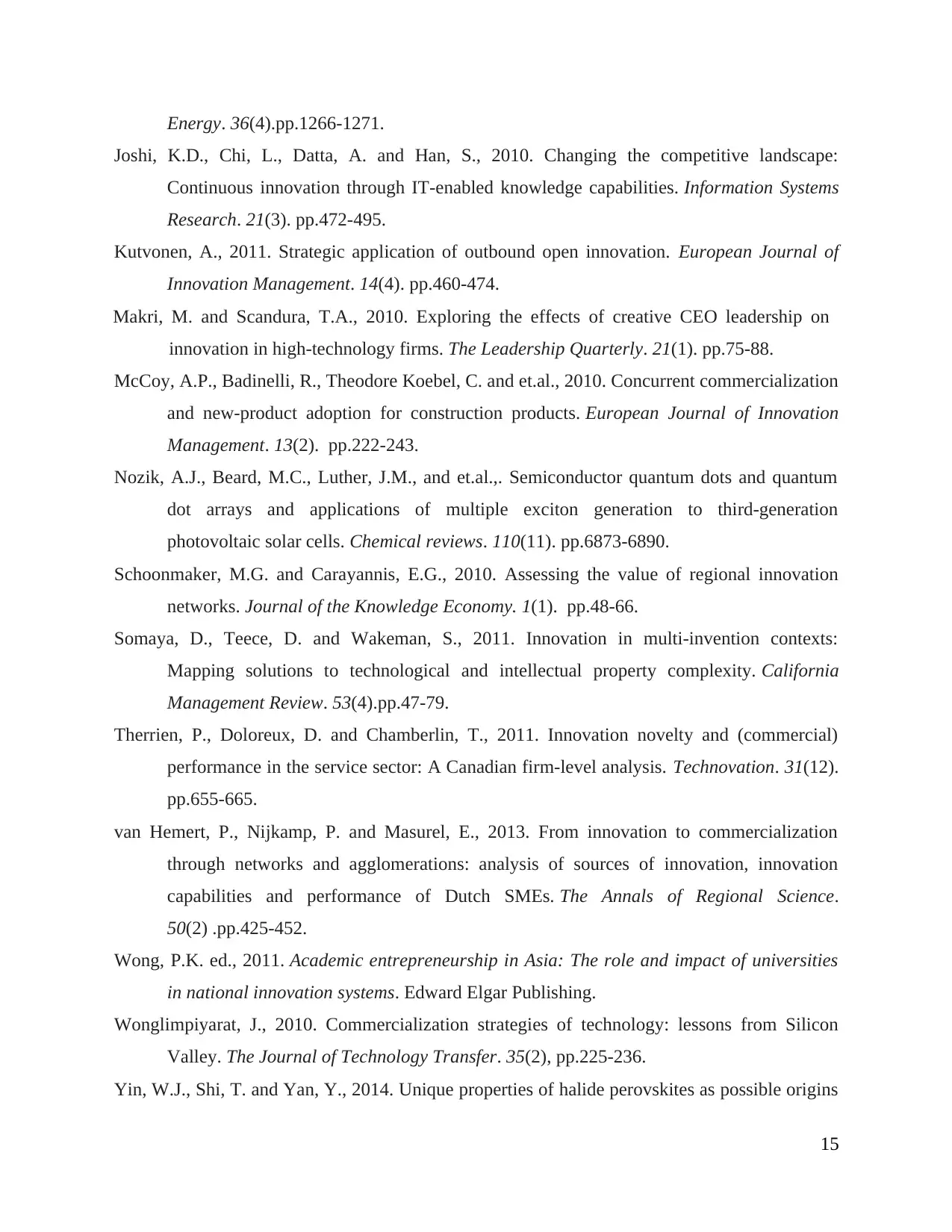
Energy. 36(4).pp.1266-1271.
Joshi, K.D., Chi, L., Datta, A. and Han, S., 2010. Changing the competitive landscape:
Continuous innovation through IT-enabled knowledge capabilities. Information Systems
Research. 21(3). pp.472-495.
Kutvonen, A., 2011. Strategic application of outbound open innovation. European Journal of
Innovation Management. 14(4). pp.460-474.
Makri, M. and Scandura, T.A., 2010. Exploring the effects of creative CEO leadership on
innovation in high-technology firms. The Leadership Quarterly. 21(1). pp.75-88.
McCoy, A.P., Badinelli, R., Theodore Koebel, C. and et.al., 2010. Concurrent commercialization
and new-product adoption for construction products. European Journal of Innovation
Management. 13(2). pp.222-243.
Nozik, A.J., Beard, M.C., Luther, J.M., and et.al.,. Semiconductor quantum dots and quantum
dot arrays and applications of multiple exciton generation to third-generation
photovoltaic solar cells. Chemical reviews. 110(11). pp.6873-6890.
Schoonmaker, M.G. and Carayannis, E.G., 2010. Assessing the value of regional innovation
networks. Journal of the Knowledge Economy. 1(1). pp.48-66.
Somaya, D., Teece, D. and Wakeman, S., 2011. Innovation in multi-invention contexts:
Mapping solutions to technological and intellectual property complexity. California
Management Review. 53(4).pp.47-79.
Therrien, P., Doloreux, D. and Chamberlin, T., 2011. Innovation novelty and (commercial)
performance in the service sector: A Canadian firm-level analysis. Technovation. 31(12).
pp.655-665.
van Hemert, P., Nijkamp, P. and Masurel, E., 2013. From innovation to commercialization
through networks and agglomerations: analysis of sources of innovation, innovation
capabilities and performance of Dutch SMEs. The Annals of Regional Science.
50(2) .pp.425-452.
Wong, P.K. ed., 2011. Academic entrepreneurship in Asia: The role and impact of universities
in national innovation systems. Edward Elgar Publishing.
Wonglimpiyarat, J., 2010. Commercialization strategies of technology: lessons from Silicon
Valley. The Journal of Technology Transfer. 35(2), pp.225-236.
Yin, W.J., Shi, T. and Yan, Y., 2014. Unique properties of halide perovskites as possible origins
15
Joshi, K.D., Chi, L., Datta, A. and Han, S., 2010. Changing the competitive landscape:
Continuous innovation through IT-enabled knowledge capabilities. Information Systems
Research. 21(3). pp.472-495.
Kutvonen, A., 2011. Strategic application of outbound open innovation. European Journal of
Innovation Management. 14(4). pp.460-474.
Makri, M. and Scandura, T.A., 2010. Exploring the effects of creative CEO leadership on
innovation in high-technology firms. The Leadership Quarterly. 21(1). pp.75-88.
McCoy, A.P., Badinelli, R., Theodore Koebel, C. and et.al., 2010. Concurrent commercialization
and new-product adoption for construction products. European Journal of Innovation
Management. 13(2). pp.222-243.
Nozik, A.J., Beard, M.C., Luther, J.M., and et.al.,. Semiconductor quantum dots and quantum
dot arrays and applications of multiple exciton generation to third-generation
photovoltaic solar cells. Chemical reviews. 110(11). pp.6873-6890.
Schoonmaker, M.G. and Carayannis, E.G., 2010. Assessing the value of regional innovation
networks. Journal of the Knowledge Economy. 1(1). pp.48-66.
Somaya, D., Teece, D. and Wakeman, S., 2011. Innovation in multi-invention contexts:
Mapping solutions to technological and intellectual property complexity. California
Management Review. 53(4).pp.47-79.
Therrien, P., Doloreux, D. and Chamberlin, T., 2011. Innovation novelty and (commercial)
performance in the service sector: A Canadian firm-level analysis. Technovation. 31(12).
pp.655-665.
van Hemert, P., Nijkamp, P. and Masurel, E., 2013. From innovation to commercialization
through networks and agglomerations: analysis of sources of innovation, innovation
capabilities and performance of Dutch SMEs. The Annals of Regional Science.
50(2) .pp.425-452.
Wong, P.K. ed., 2011. Academic entrepreneurship in Asia: The role and impact of universities
in national innovation systems. Edward Elgar Publishing.
Wonglimpiyarat, J., 2010. Commercialization strategies of technology: lessons from Silicon
Valley. The Journal of Technology Transfer. 35(2), pp.225-236.
Yin, W.J., Shi, T. and Yan, Y., 2014. Unique properties of halide perovskites as possible origins
15
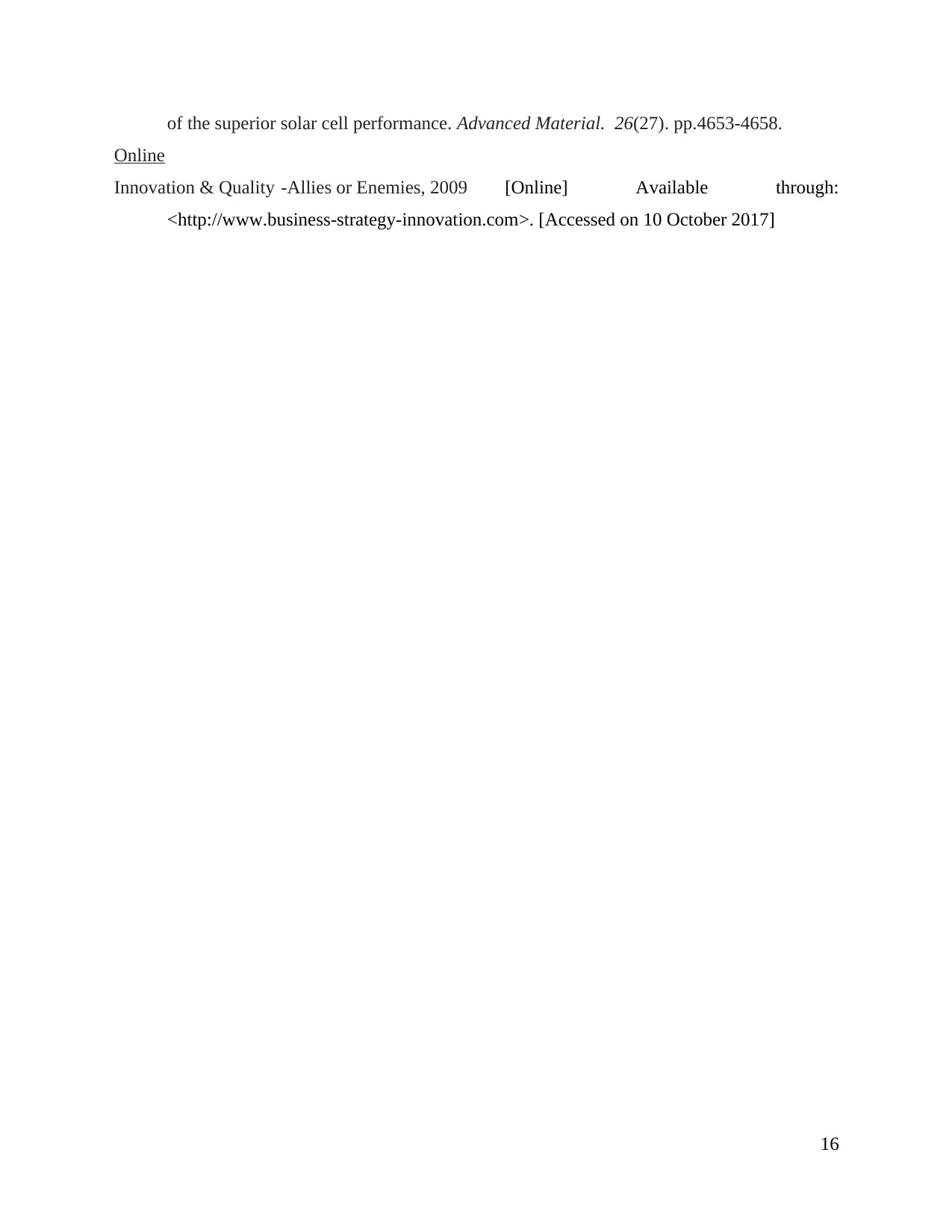
of the superior solar cell performance. Advanced Material. 26(27). pp.4653-4658.
Online
Innovation & Quality -Allies or Enemies, 2009 [Online] Available through:
<http://www.business-strategy-innovation.com>. [Accessed on 10 October 2017]
16
Online
Innovation & Quality -Allies or Enemies, 2009 [Online] Available through:
<http://www.business-strategy-innovation.com>. [Accessed on 10 October 2017]
16
1 out of 18
Related Documents
Your All-in-One AI-Powered Toolkit for Academic Success.
+13062052269
info@desklib.com
Available 24*7 on WhatsApp / Email
![[object Object]](/_next/static/media/star-bottom.7253800d.svg)
Unlock your academic potential
© 2024 | Zucol Services PVT LTD | All rights reserved.





